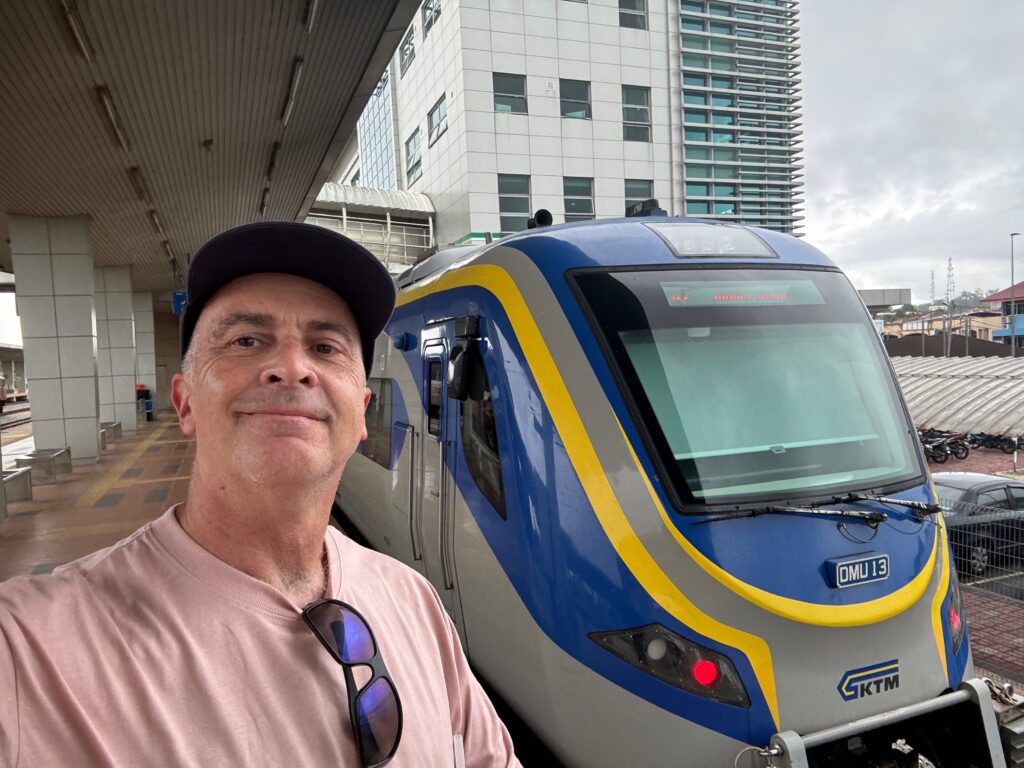
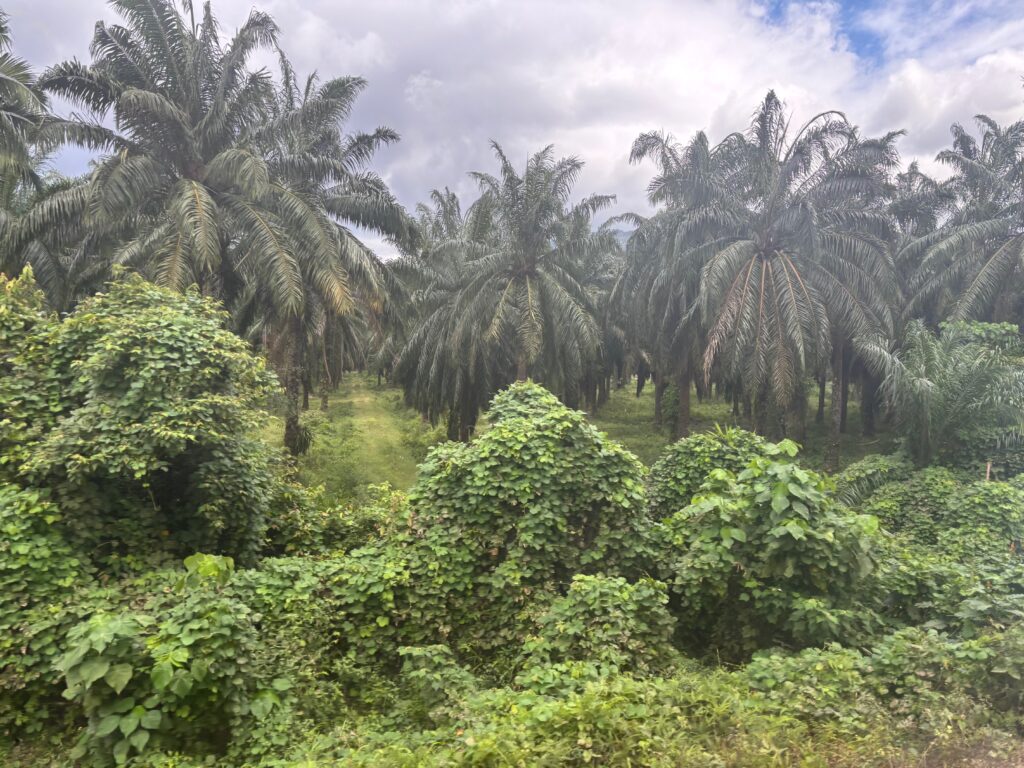
The Jungle Line (Malaysian East Coast Railway) was one of the most stunning and enjoyable train rides ever! Time flew by, and I got off the train feeling like I had completed an adventure.
Summary
- Rating: 97%
- Route: East Coast railway Train 1 Gemas to Kuala Lipis Train and 2: Kuala Lipis to Tumpat
- Provider: KTM, Keretapi Tanah Melayu Berhad or Malayan Railway Limited,
- Fare Paid: 9 MYR and 53 MYR, for a total of 62 MYR ($USD13.83)
- Highlights: Stunning scenery, Great trains, friendly people, attentive and helpful staff
- What Could Have Been Better: The toilets on the last train, buffet car food selection and coffee quality
Yesterday, I outlined how to ride Malaysia’s rail system. The country has two main rail corridors, in addition to the rail network around Kuala Lumpur.
The first, the West Coast railway (red line), connects most major Malaysian cities along the country’s western side.
The other is the far less busy, much more remote “East Coast Railway” (blue line), which connects the town of Gemas to the city of Tumpat via the Eastern jungles. None of the towns on this line are tourist centres.
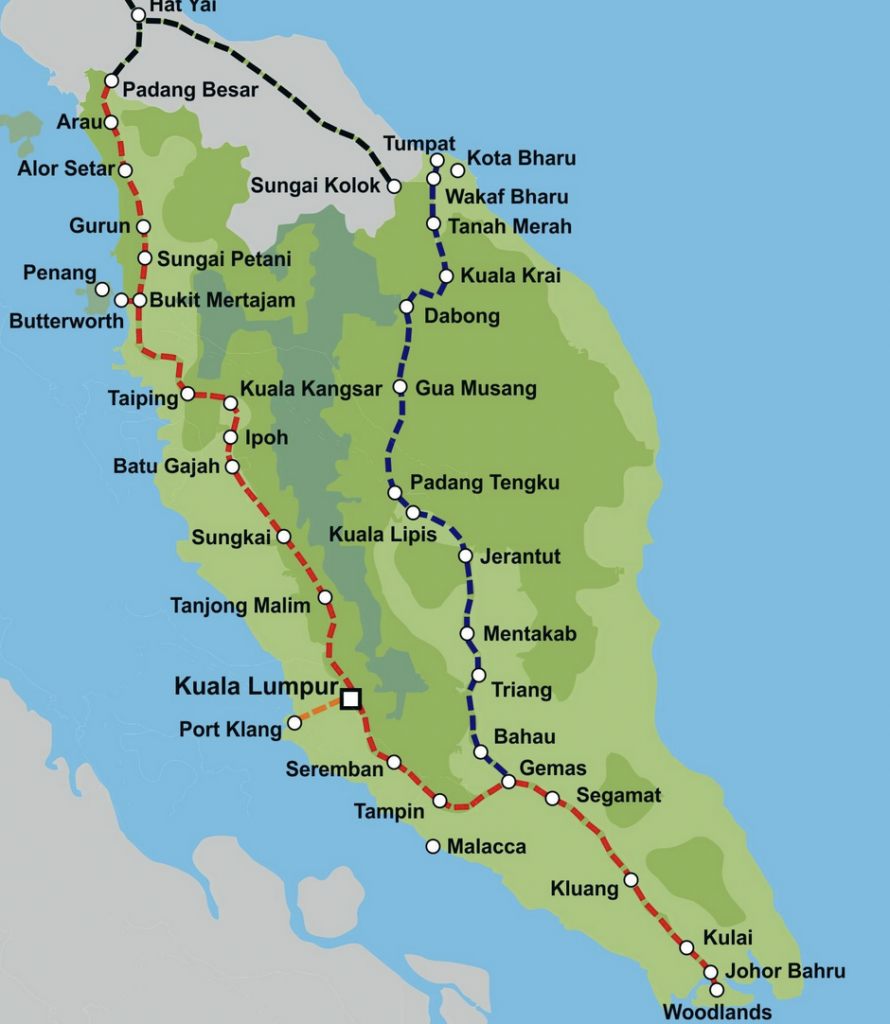
My Route
I wanted to maximise the number of daylight hours on the jungle line. To achieve this, I chose to ride from Gemas and work northwards.
I started by hopping onto the high-speed ETS, leaving Kuala Lumpur at 1215 and arriving in Gemas at 14:40 (2:40pm). This is the first train pictured on the left side below.
I waited about an hour and then took the 15:35h (3:35pm) Jungle train north to Kuala Lipis, a town on the East Coast route, arriving at 20:17h. This is the middle train below. At Kuala Lipis, I overnighted in a hotel.
The following day, I caught the sleeper service that had started at Johor Bahru. It reached Kuala Lipis at 6:11 a.m. and Tumpat at the end of the line at 12:54. Pictured right below.
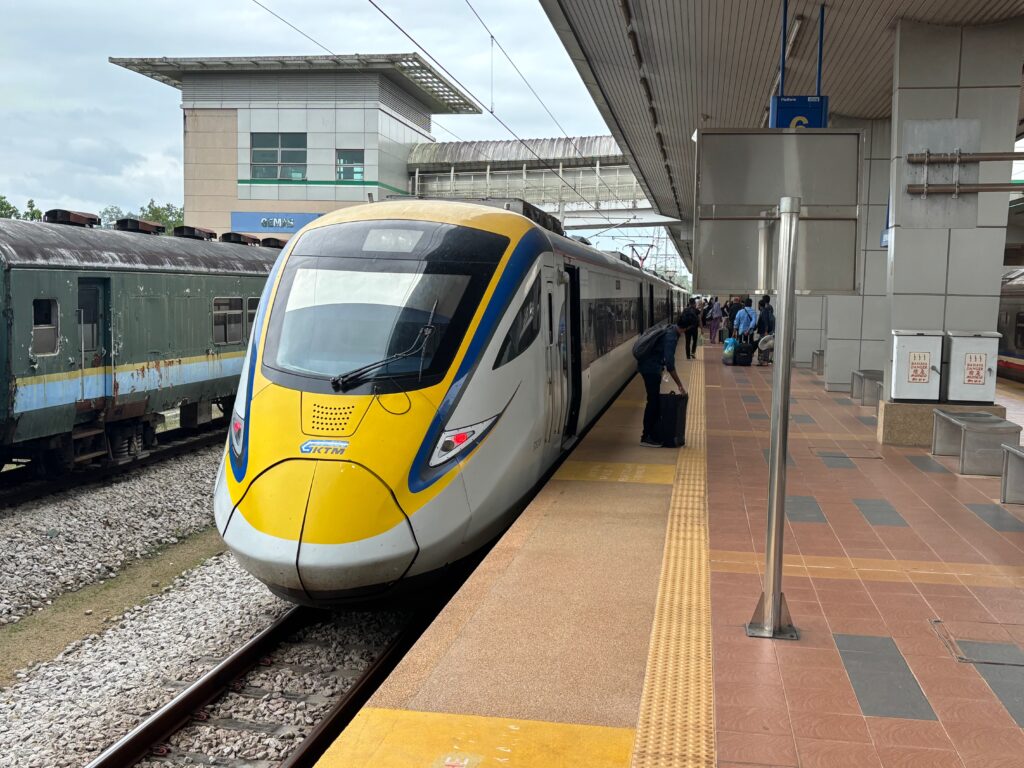
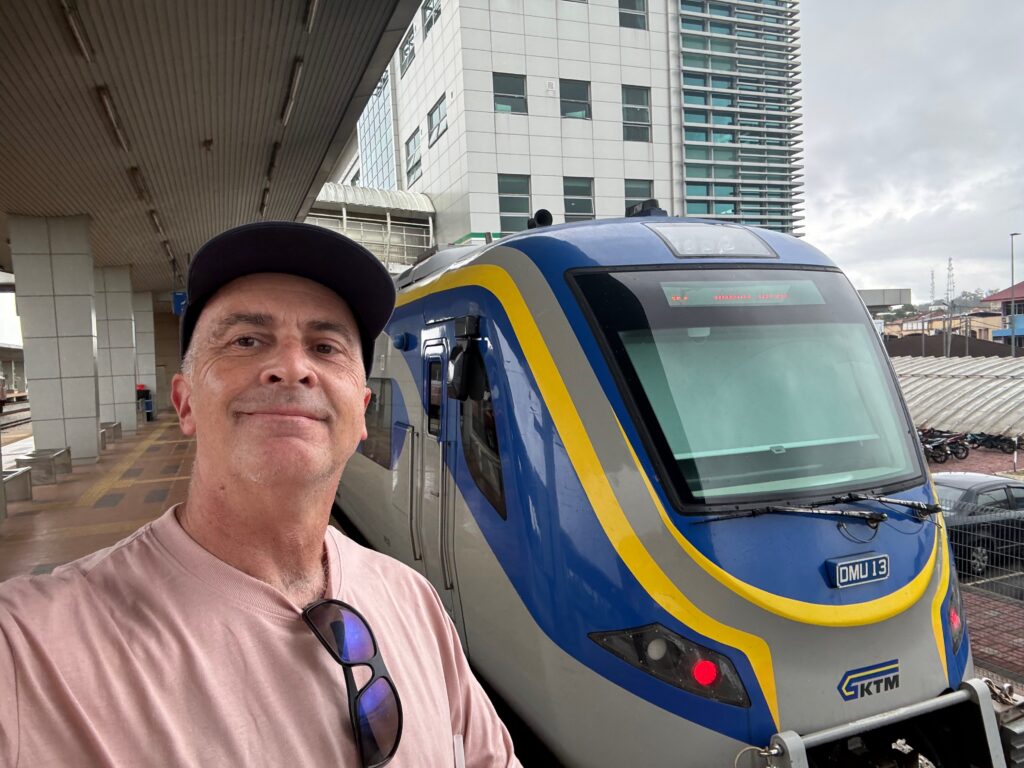
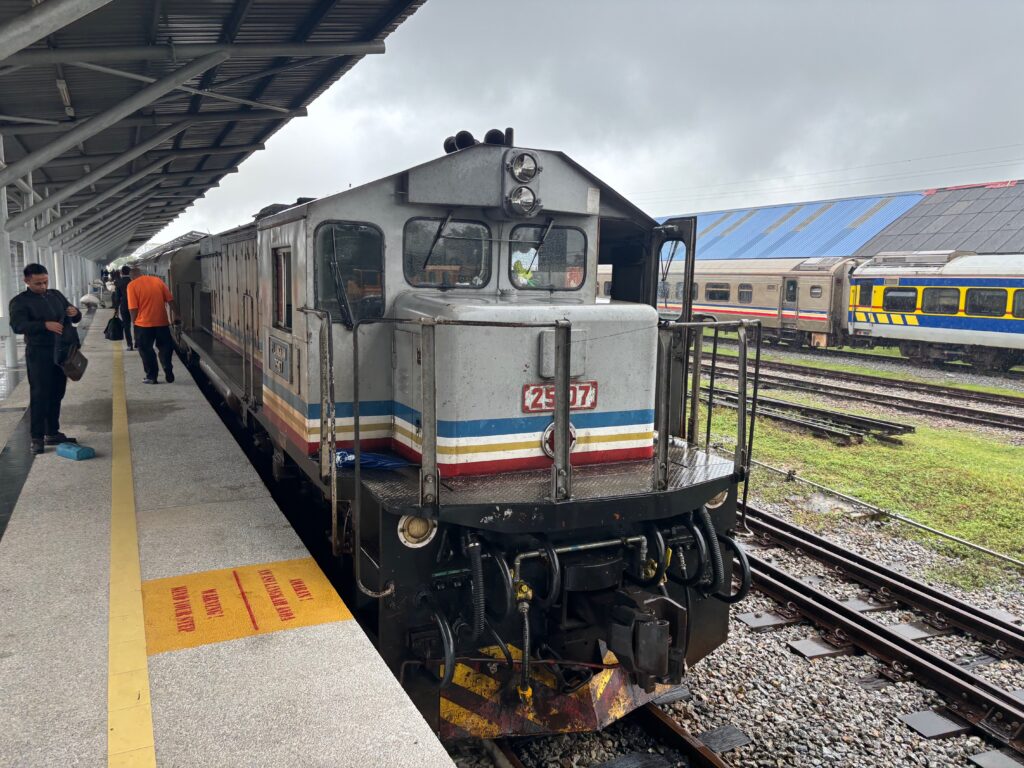
Some History of the East Coast Railway.
The Federated Malay States Railway (FMSR), formed in 1901, completed the North-South trunk line (now the West Coast railway) by 1909. The original Gemas station opened in 1906 but was superseded by a new one in 2012. The East Coast Line from Gemas was built between 1910 and 1931. It connected to Thailand via a bridge over the Golok River in 1954.
Booking
Thanks to the KTM app, booking was seamless. As a registered app user, I simply selected the route, chose the date, picked the train, and paid all in minutes.
I used two different international cards and both worked seamlessly.
The app instantly generates a QR code, which is used to board at the train stations. The train conductors also scan the QR code during the journey.
You can also visit a station with ticket machines or staffed windows.
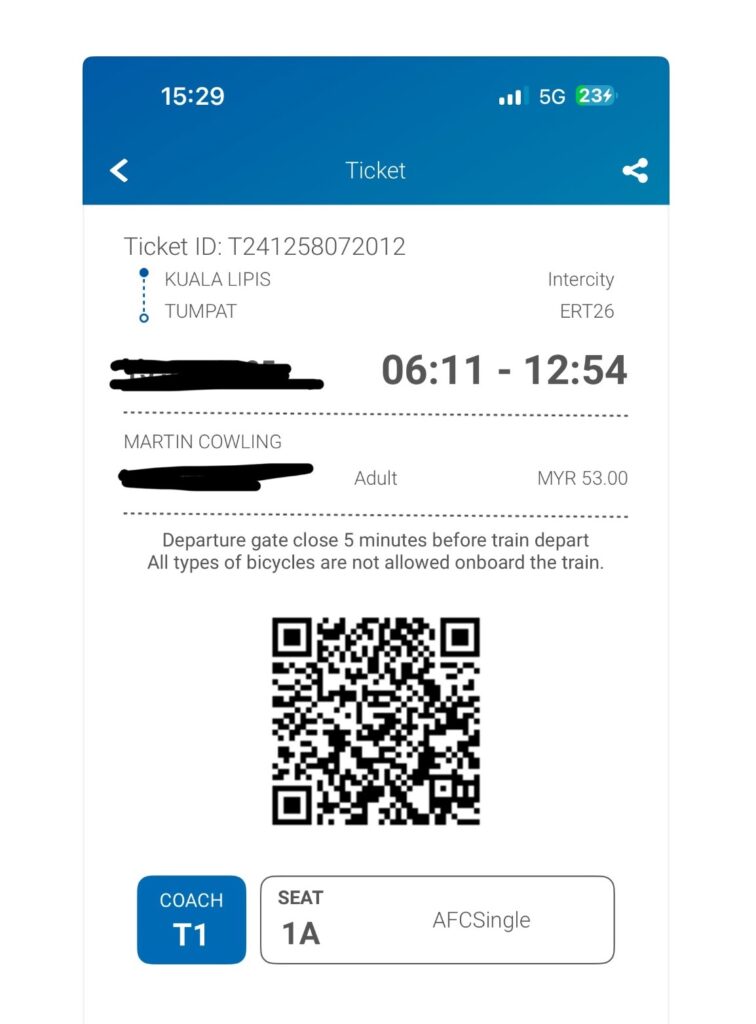
First Train Gemas to Kuala Lipis on a Modern Diesel Electric Train
The original Gemas station, which opened in 1909, stands as a historical structure beside the newer, less attractive 2012 station complex. There are cafés at the old and new station buildings, plus clean, free lavatories upstairs. During my wait between trains, I made a loop via Zus, the Malaysian coffee chain, a few minutes walk from the station, and stopped at a nearby convenience store. There are some fast food takeaway shops close by.
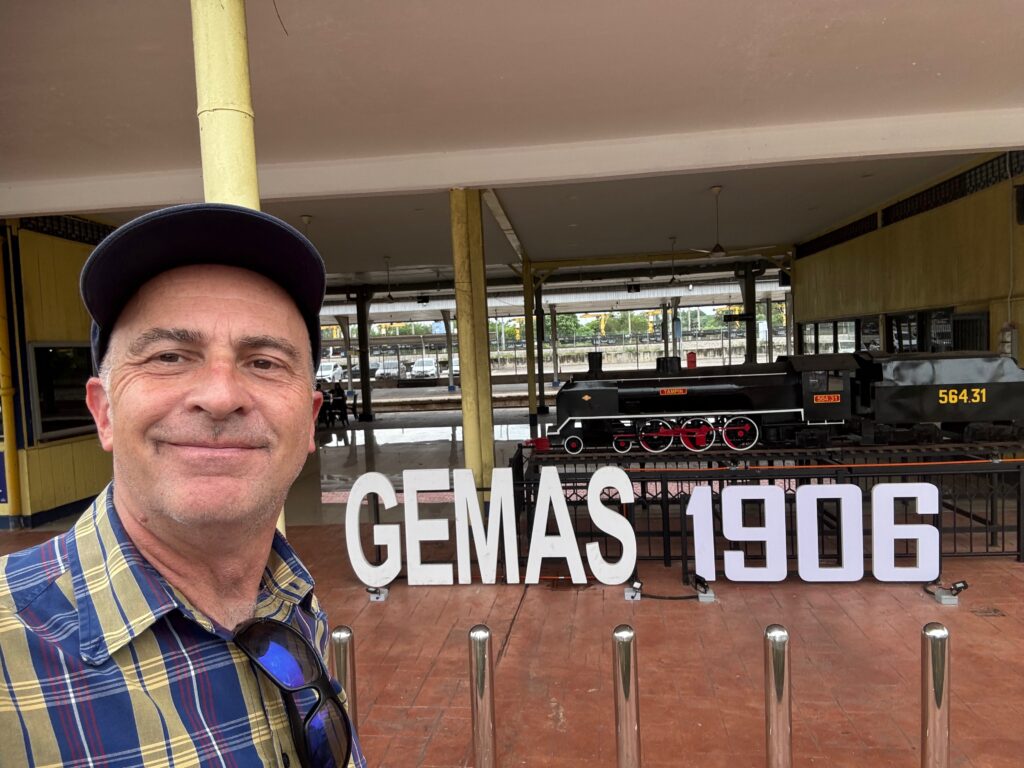
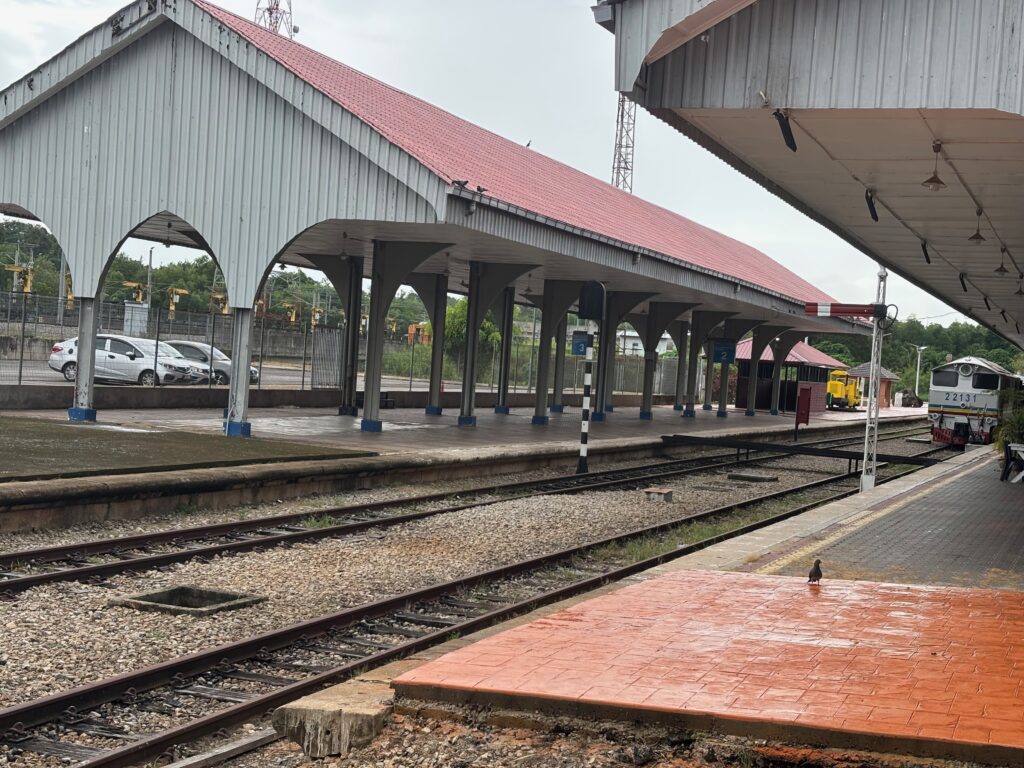
Gemas was a key railway town until sections of the Malaysian rail system began to close in the ’70s, leading to its decline. I found the town to be quite grim today.
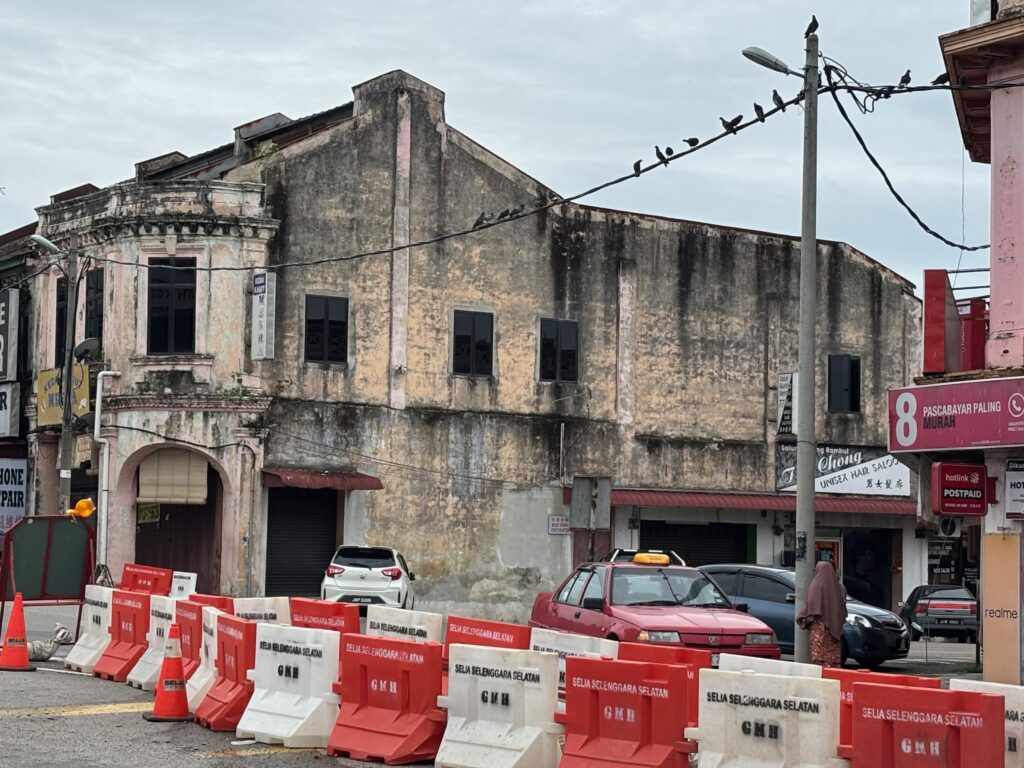
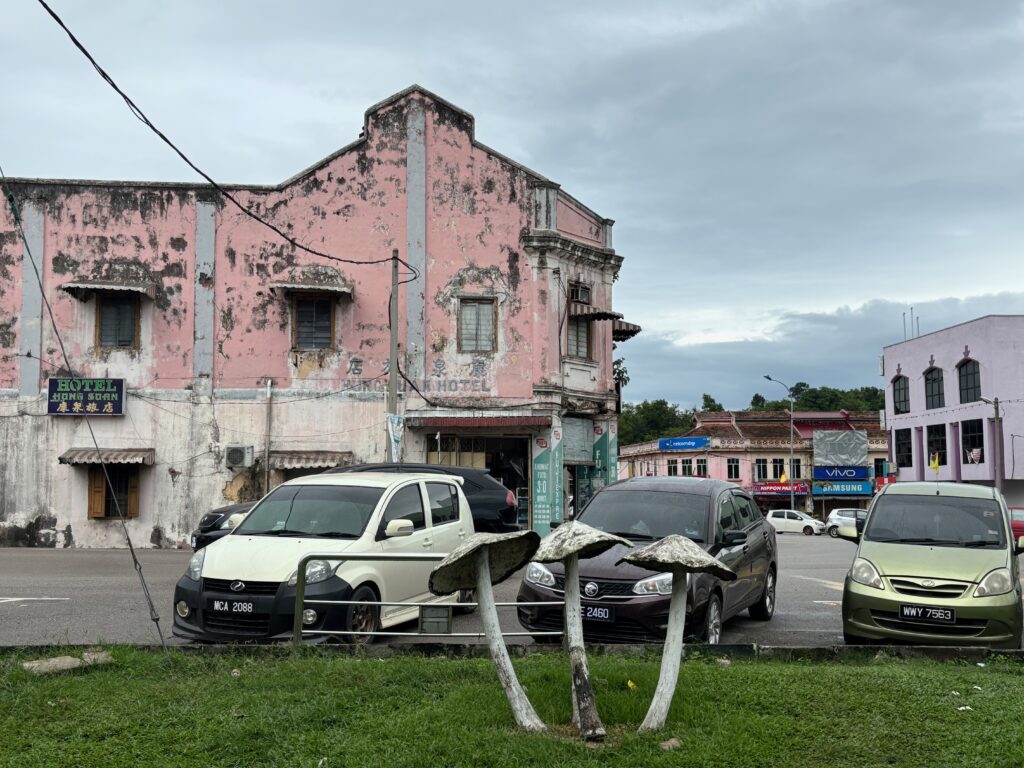
Historically, it is known for the 1942 World War Two ‘Battle of Gemas’ when Australian and British soldiers ambushed the Japanese Imperial Army. A key bridge (Gemencheh Bridge) was blown up, 800 Japanese troops were killed, wounded, or went missing. This event slowed the Japanese invasion of Malaya.
The boarding process at Gemas (GMS) was straightforward. After scanning my QR code at the ticket barriers, I found it was a short walk to the platform with stairs and a lift (elevator). Signage is in Malay and English.
Staff were present throughout, ready to answer questions. Interestingly, all five staff members I passed, were convinced I was riding the wrong train. Foreigners, apparently, don’t usually ride the East Coast Railway (I was the only non-local on board the first train and one of three on the second train). Their concern was both amusing and touching, highlighting the uniqueness of the experience. One by one, they triple-checked to make sure I knew where I was going. “Are you sure?” said one incredulously. “Tumpat? End of the line? Really?” said another.
Carriages and seats were clearly labelled with their numbers on all the rail services I used.
The Train
Keretapi Tanah Melayu Berhad (KTMB) introduced the new Diesel Multiple Unit (DMU) trains on the East Coast Line on April 11, 2021. The launch event, officiated by Transport Minister Datuk Seri Dr. Wee Ka Siong, took place at Pasir Mas Station in Kelantan. These DMUs were introduced to replace the existing KTM Intercity conventional diesel trains on the Tumpat–Kuala Lipis route.
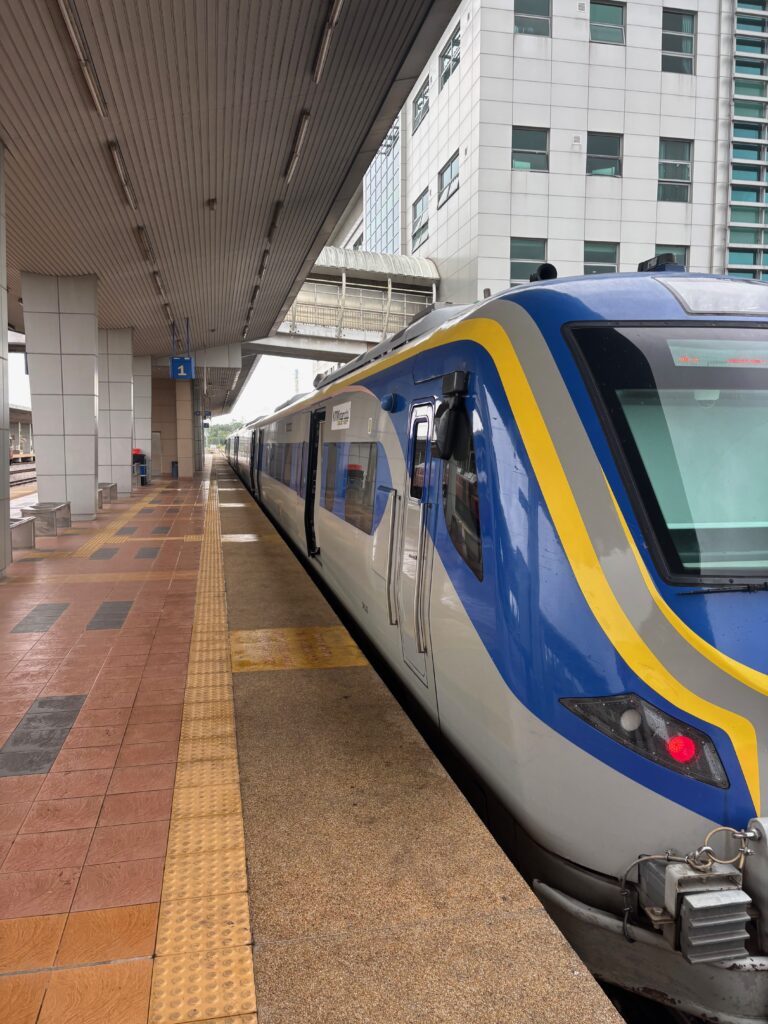
The new Diesel Electric train was a delight. It offered a modern, comfortable ride.
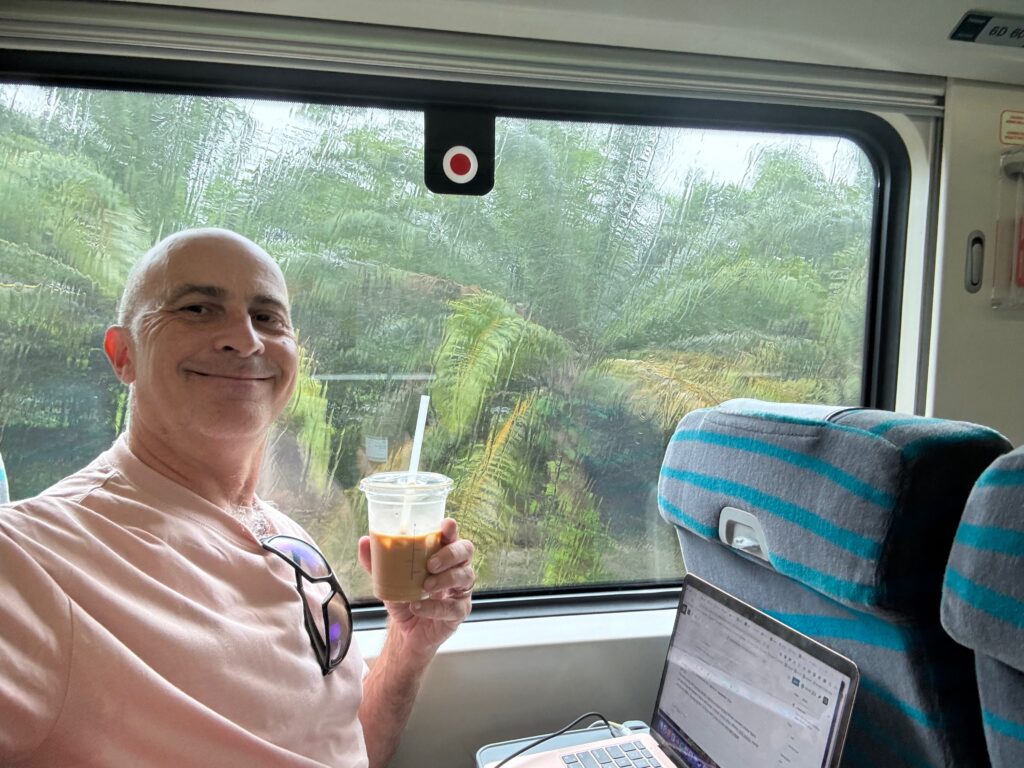
The carriages themselves are spacious. Massive windows dominate the space, allowing me to take in the sweeping views of the jungle, the setting sun on the rural landscapes, and small towns.
The seating is well-padded and reclines slightly, with plenty of legroom, making this long trip very enjoyable. I also had the carriage to myself!
Each seat has a Power outlet for charging devices, ensuring I stayed connected throughout the journey. There was no Wi-Fi, and the mobile signal varied from a full five bars in 5G to 3G and even the dreaded E- Edge (does it still exist?). On both trips, I was able to get a stack of work done on my laptop. It was great having the uninterrupted space to work while enjoying the incredible countryside.
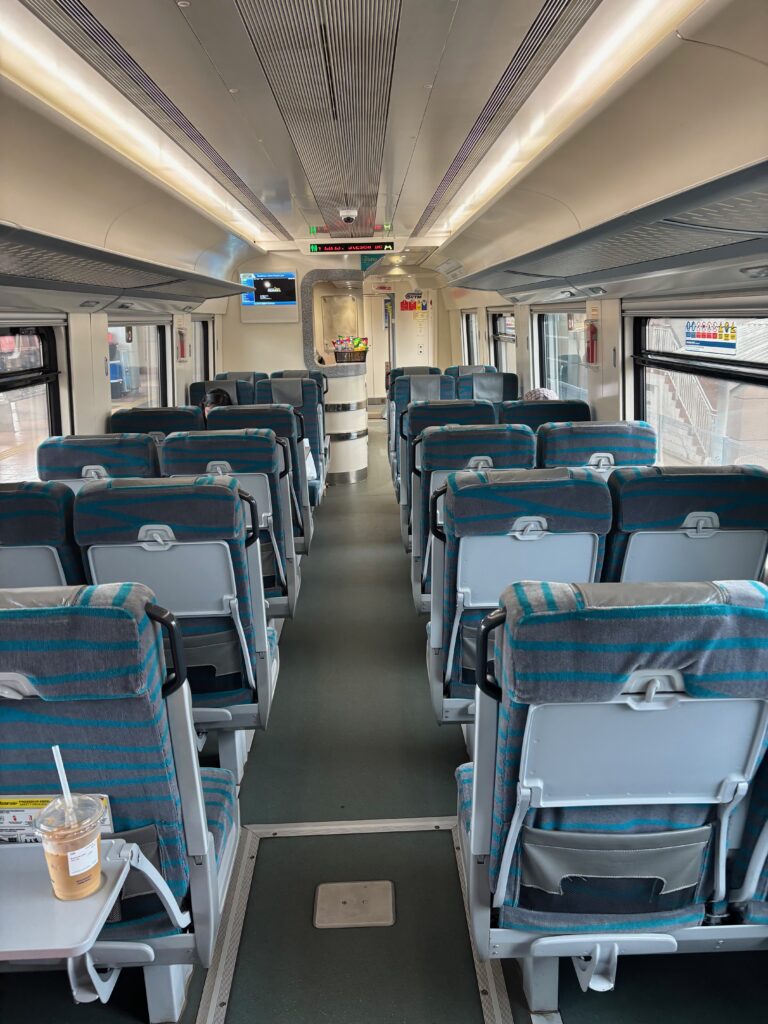
The train has a small café serving various hot and cold drinks, snacks, and light meals. The train also boasted modern, clean toilets and an onboard prayer room. The Air conditioning ran a little cool especially when compared with the usually sweltering Malaysian days.
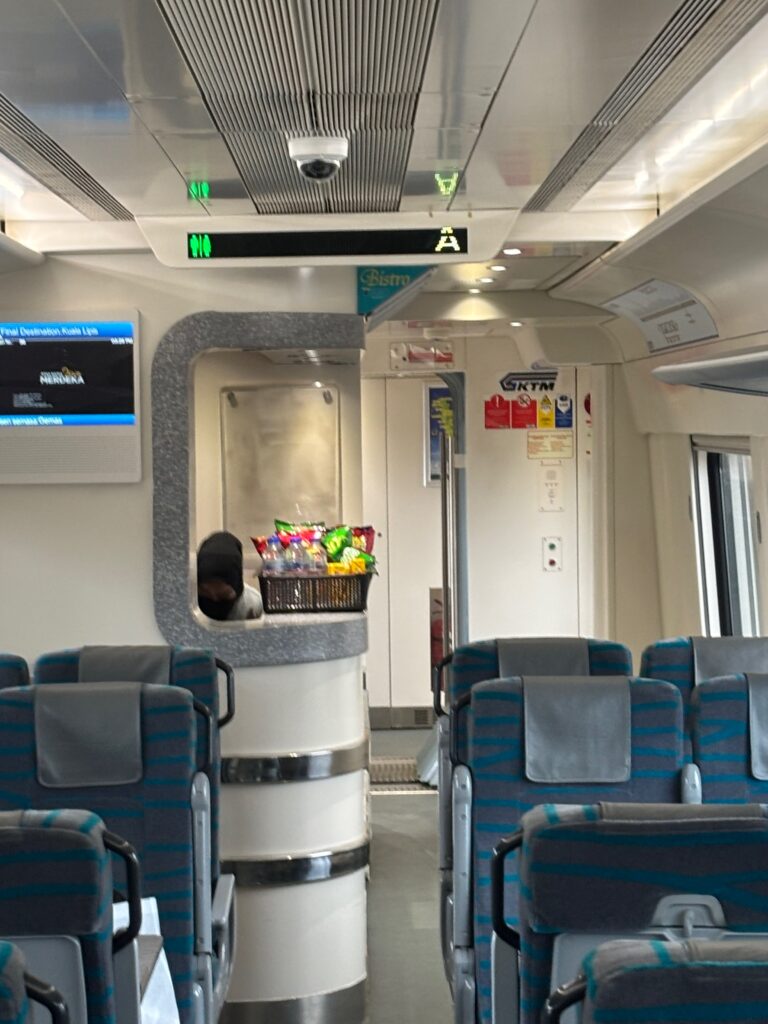
Display screens throughout the carriages provide valuable updates, including the next station, arrival times, and other travel information.
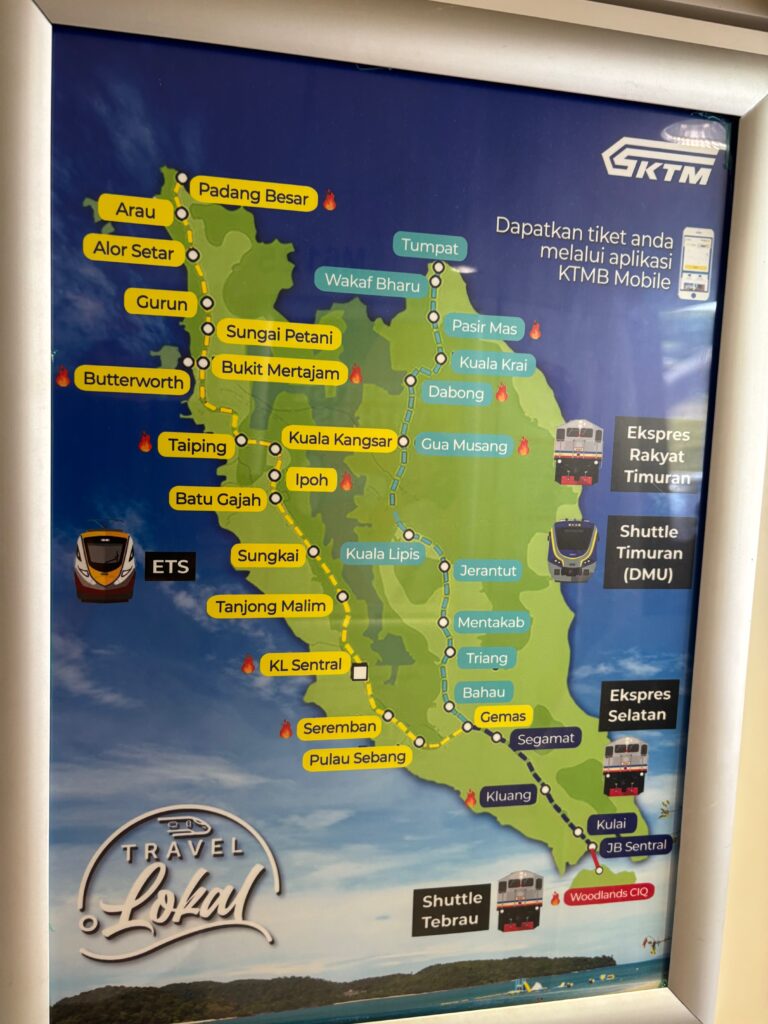
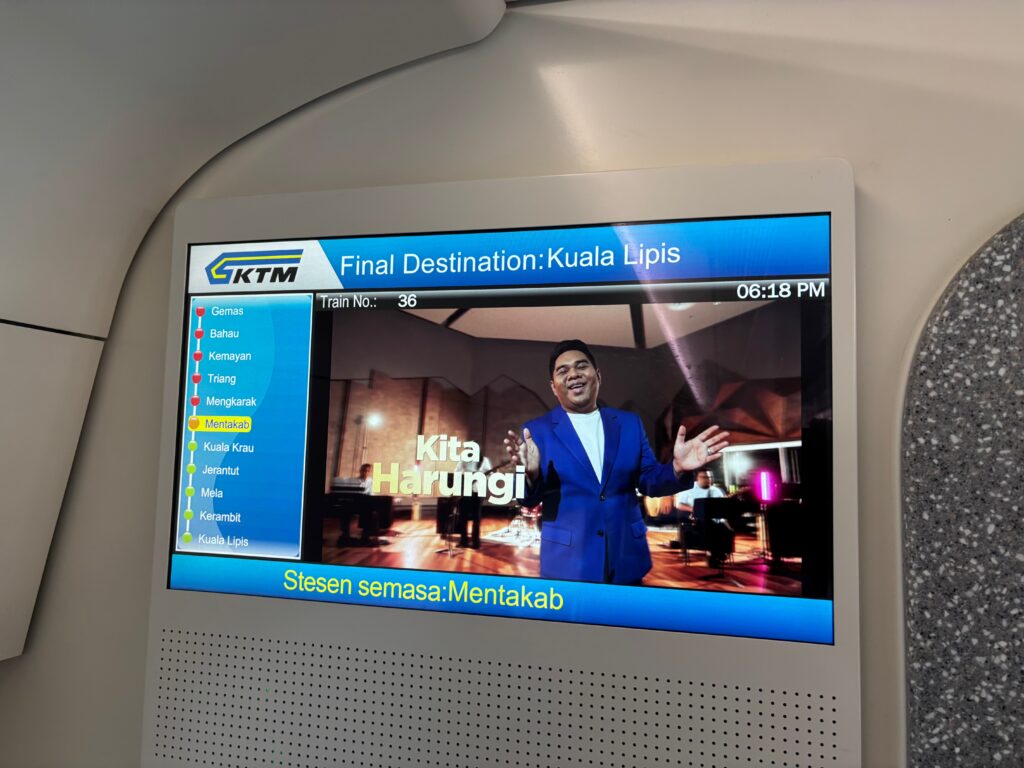
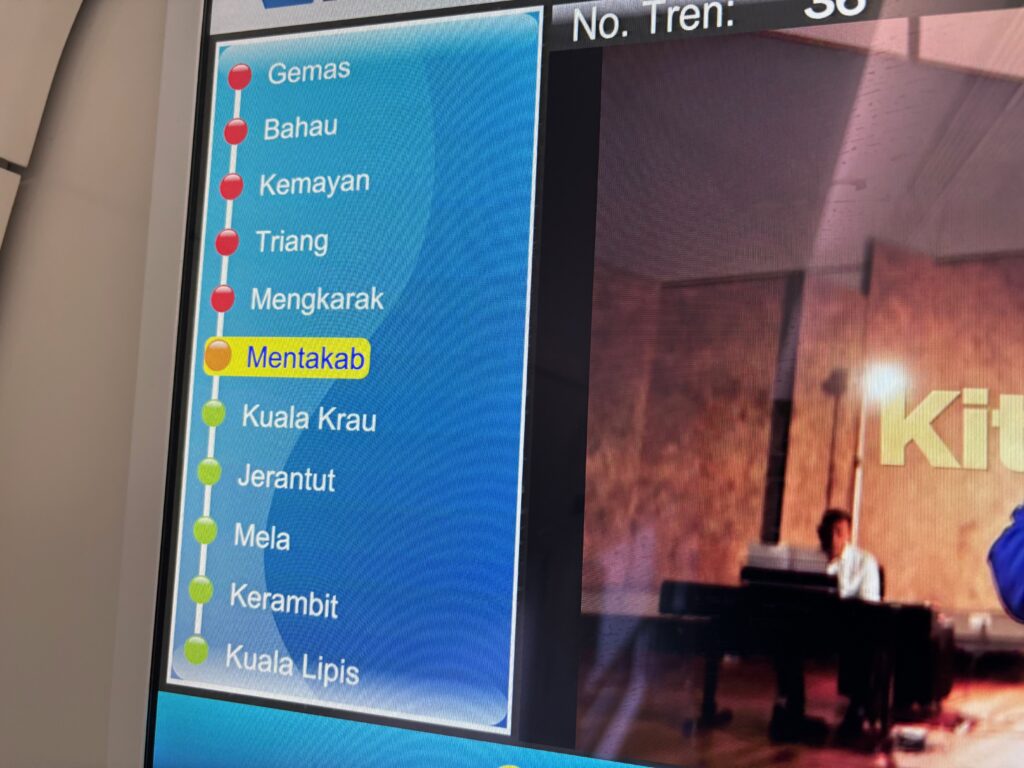
This first segment was around four hours from Gemas to Kuala Lipis. We started by riding through plantations and then moved into thicker jungle with more occasional plantations. It poured continuously for the ride through this section. The main stops were at:
- Bahau – 30 km after
- Kemayan – 70 km
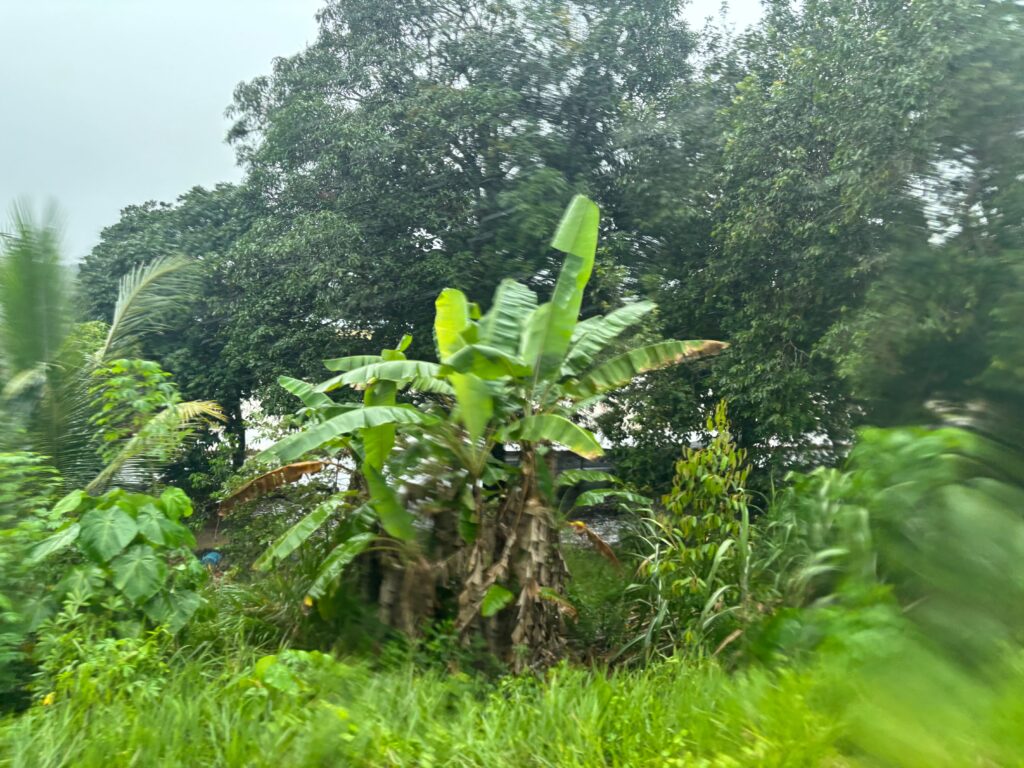
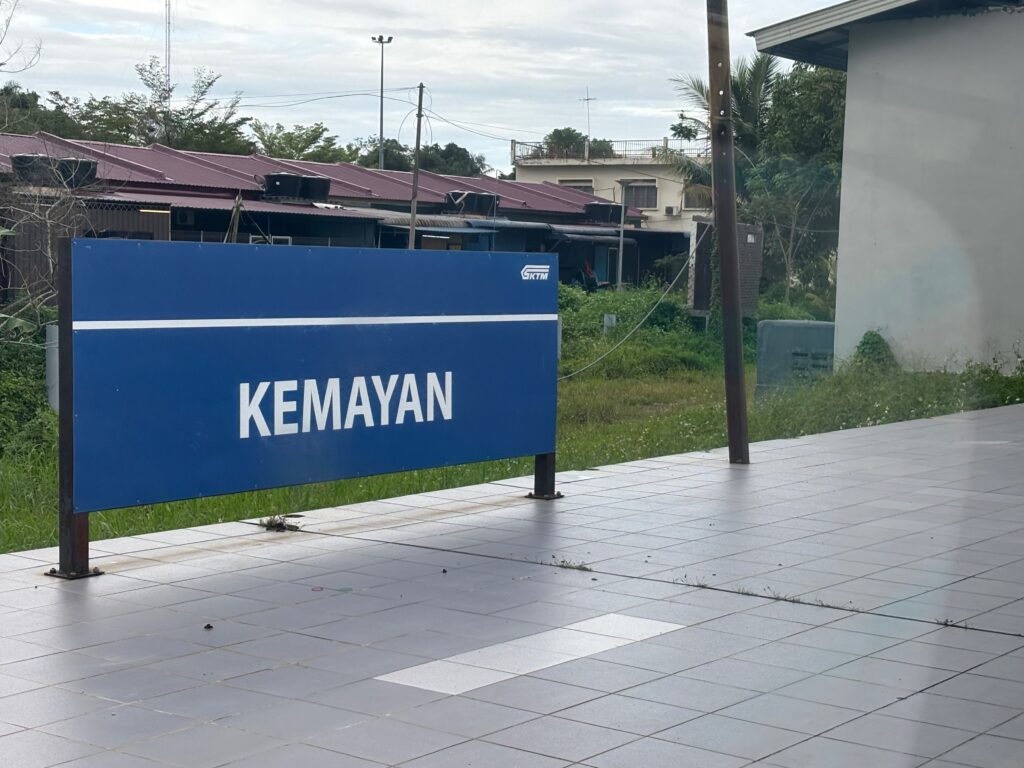
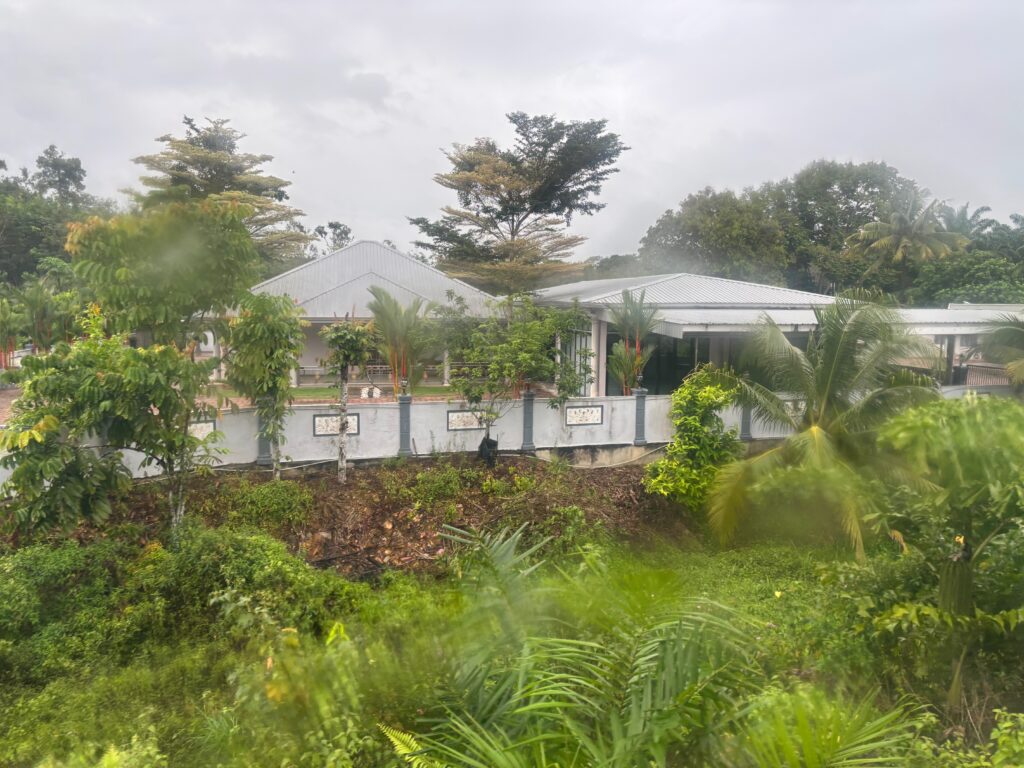
After two hours, we arrived at Triang, 90 km from the start, a rubber, and palm oil town. The name reminds me of the UK toy company. It likely originates from a Malay word “Teriang” which refers to the indigenous Orang Asli group who lived here. Over time, the British seem to have “evolved” the spelling.
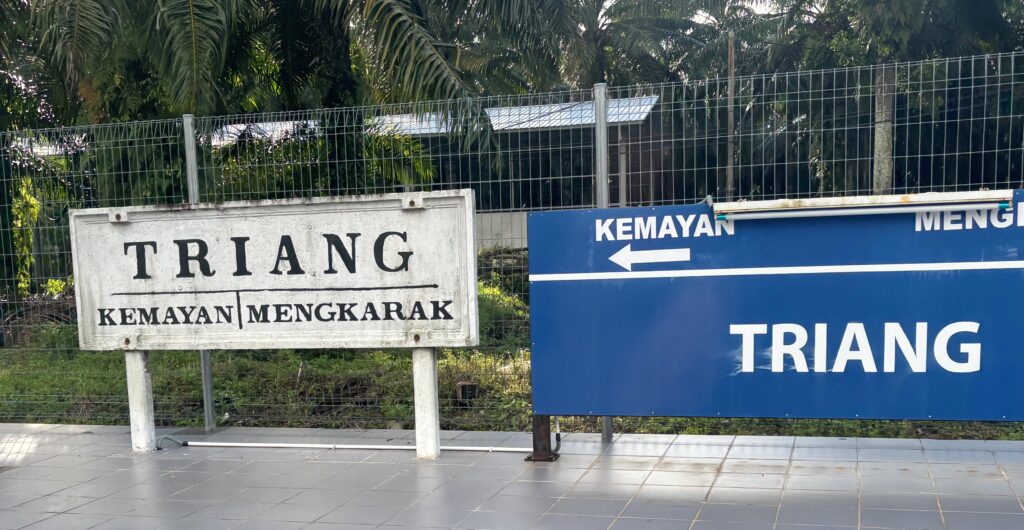
- Mengkarak – 110 km
- Mentakab – 130 km known for traditional markets and agriculture. As we arrived, the café car was packed up without any warning and the café staff got off the train. It had taken almost three hours to get here.
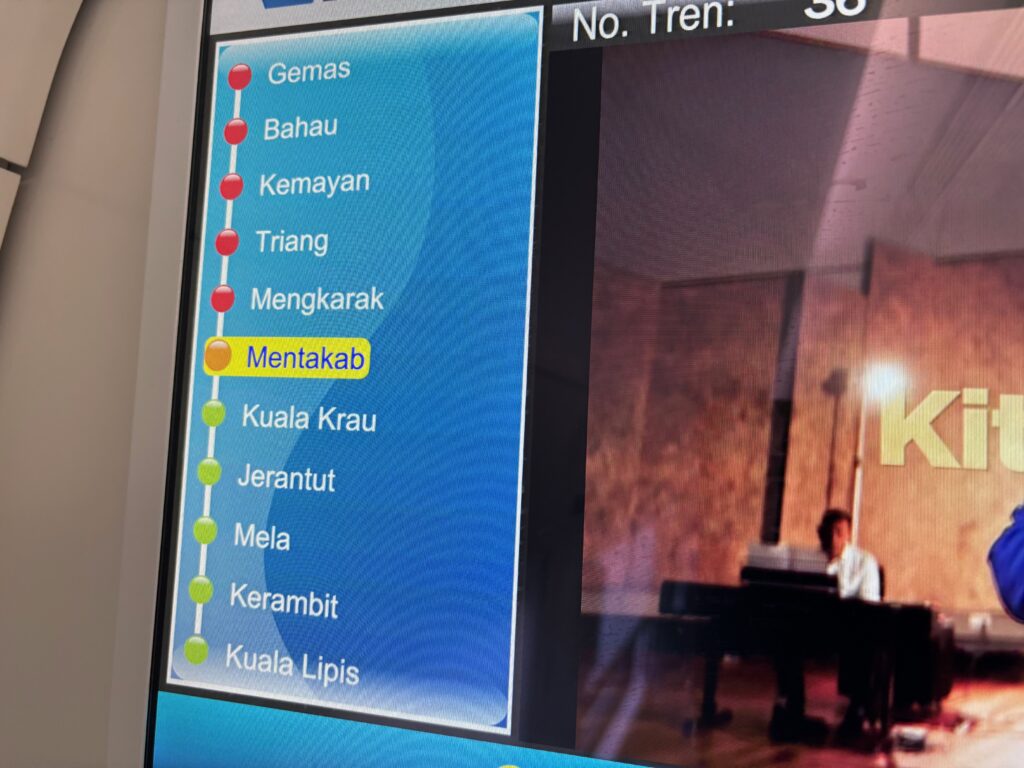
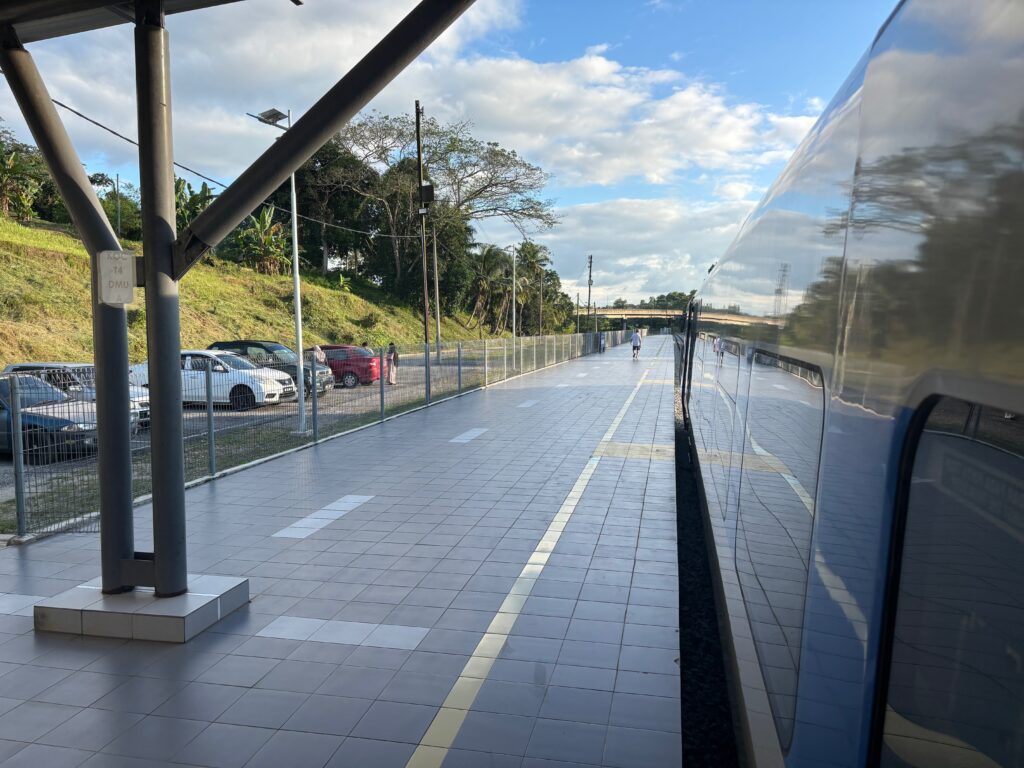
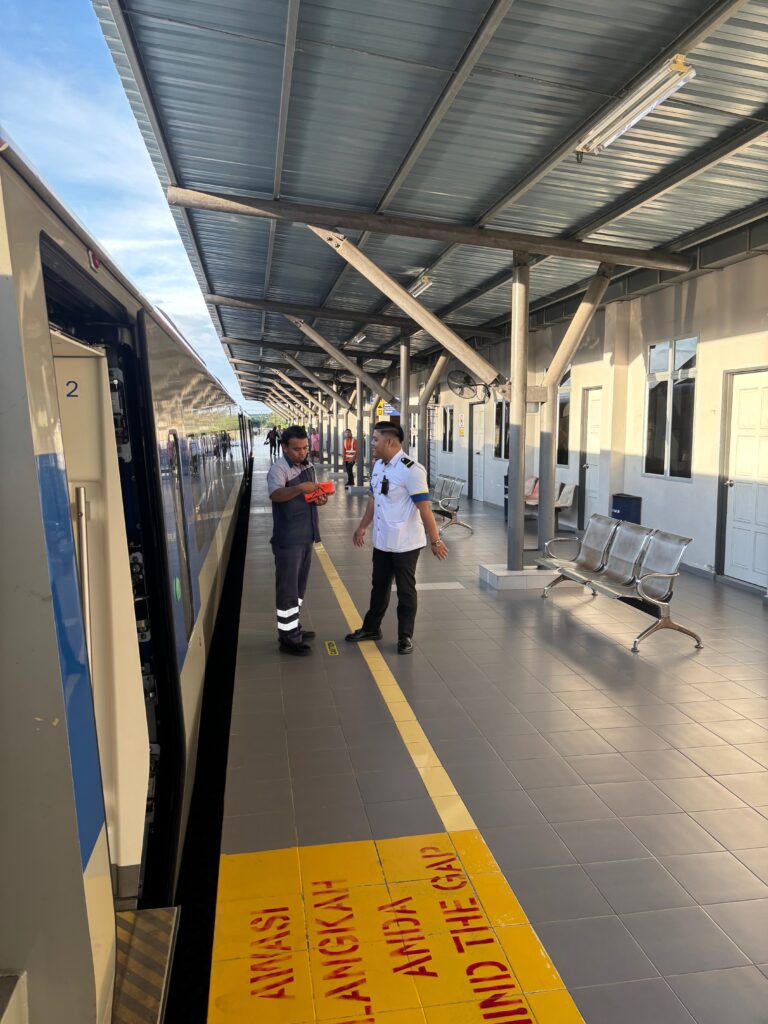
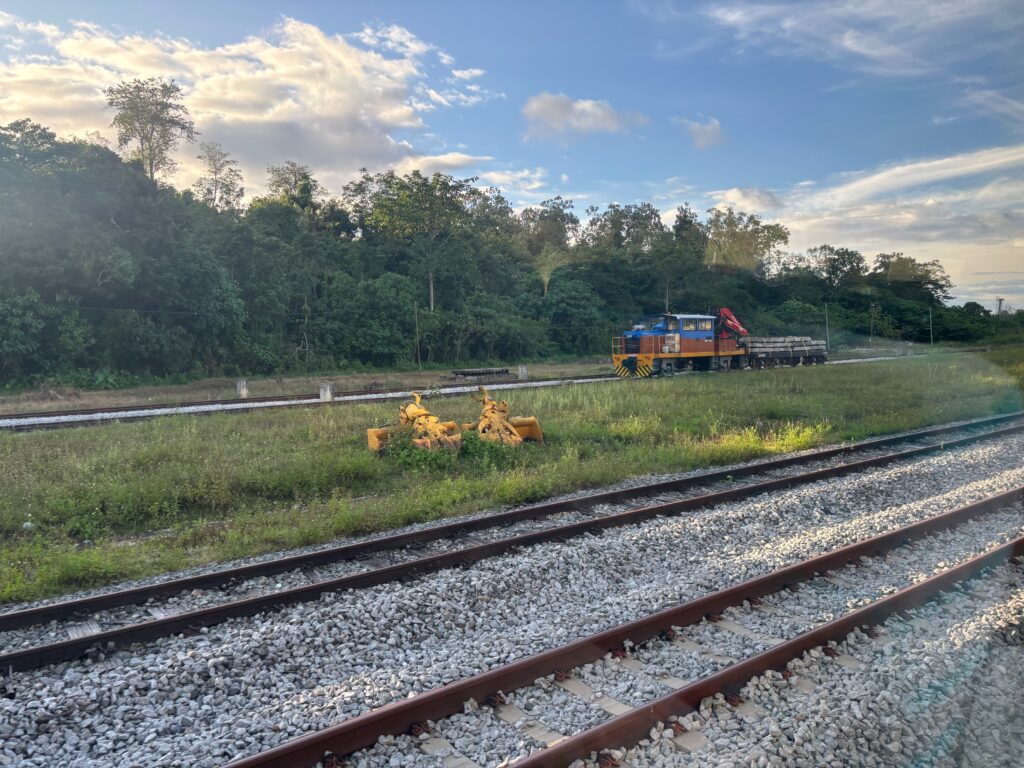
The sun began to set soon after this. The final two stops before the destination of Kuala Lipis were:
- Kuala Krau – 160 km
- Jerantut: 180km is the gateway to Taman Negara National Park
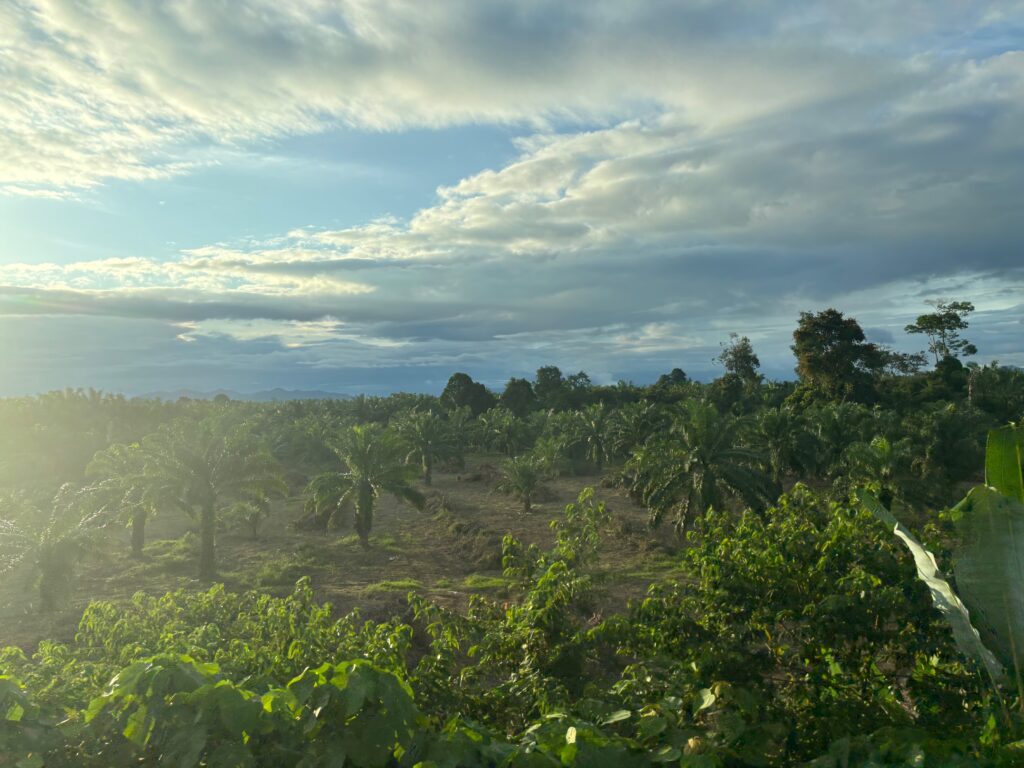
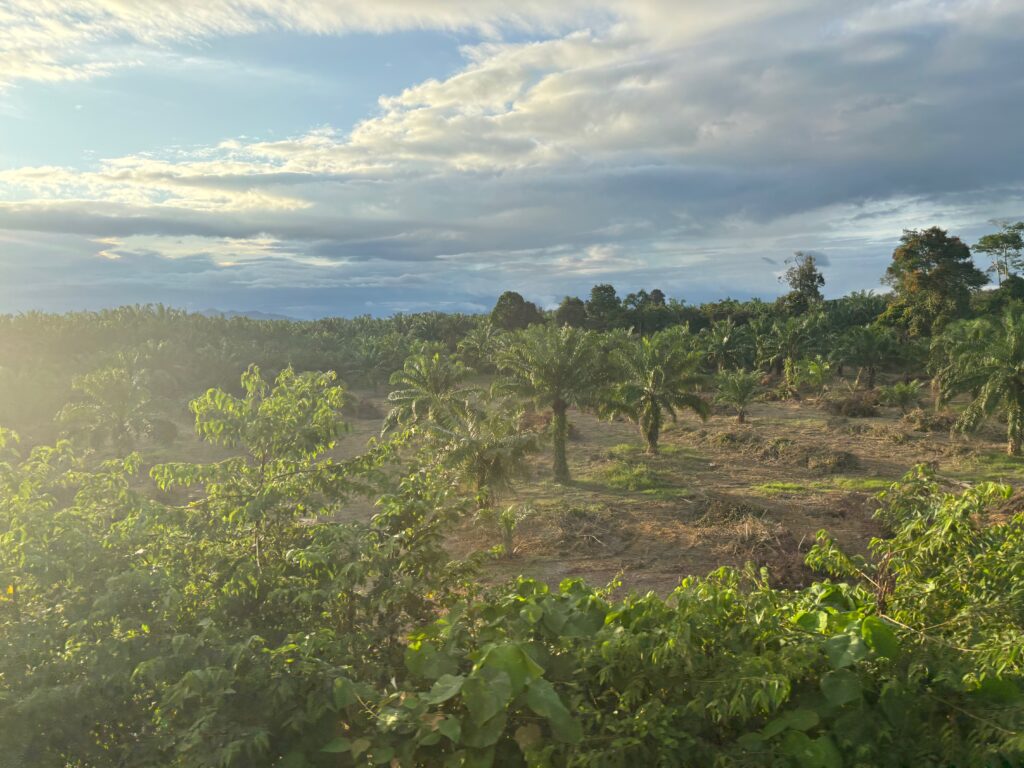
We arrived smoothly at Kuala Lipis 120 km from the start. Unfortunately, my time here was just an overnight but the town had a lovely feel. It was a former capital that has some lovely colonial architecture. It is close to national parks like Taman Negara and Kuala Tahan.
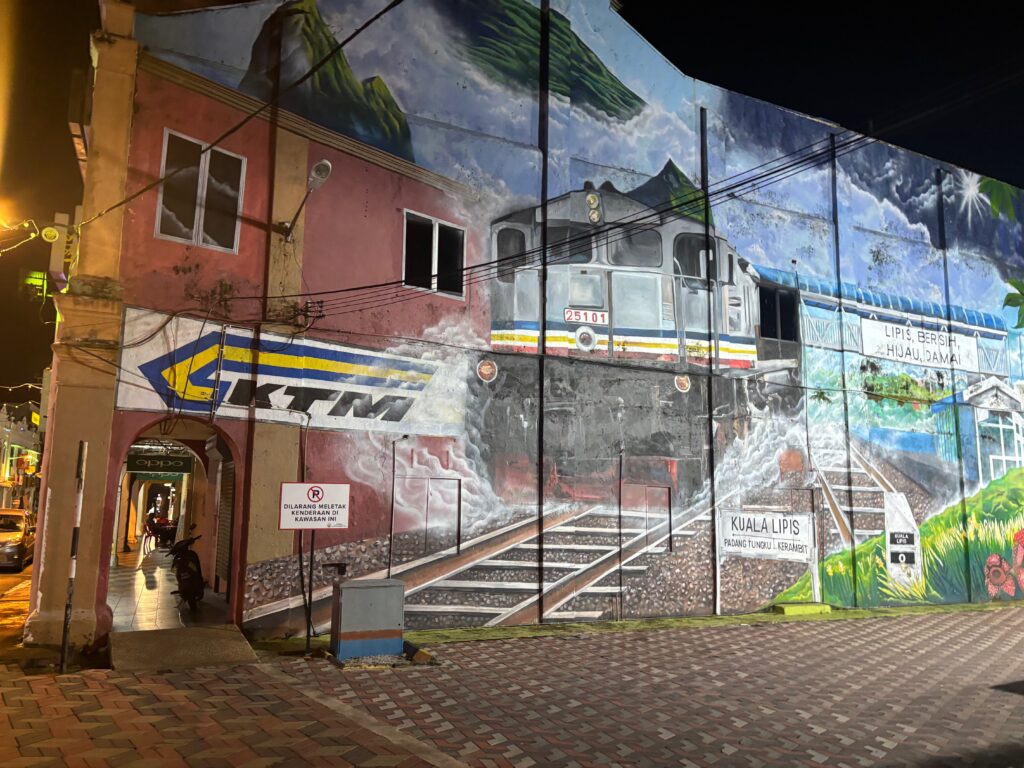
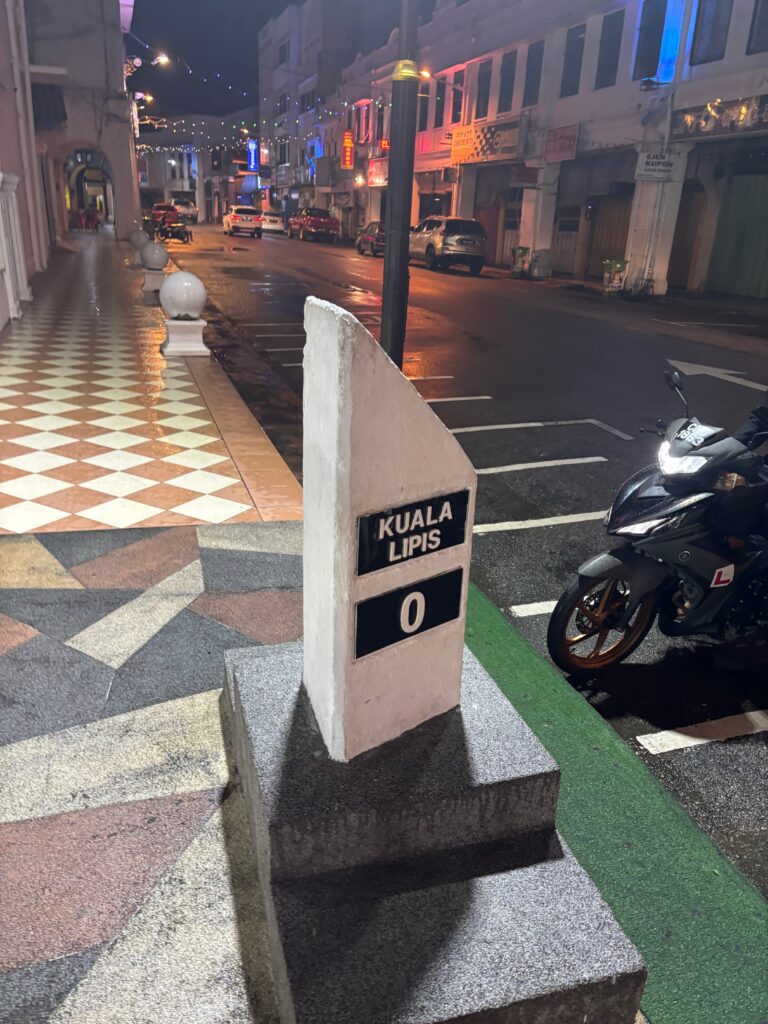
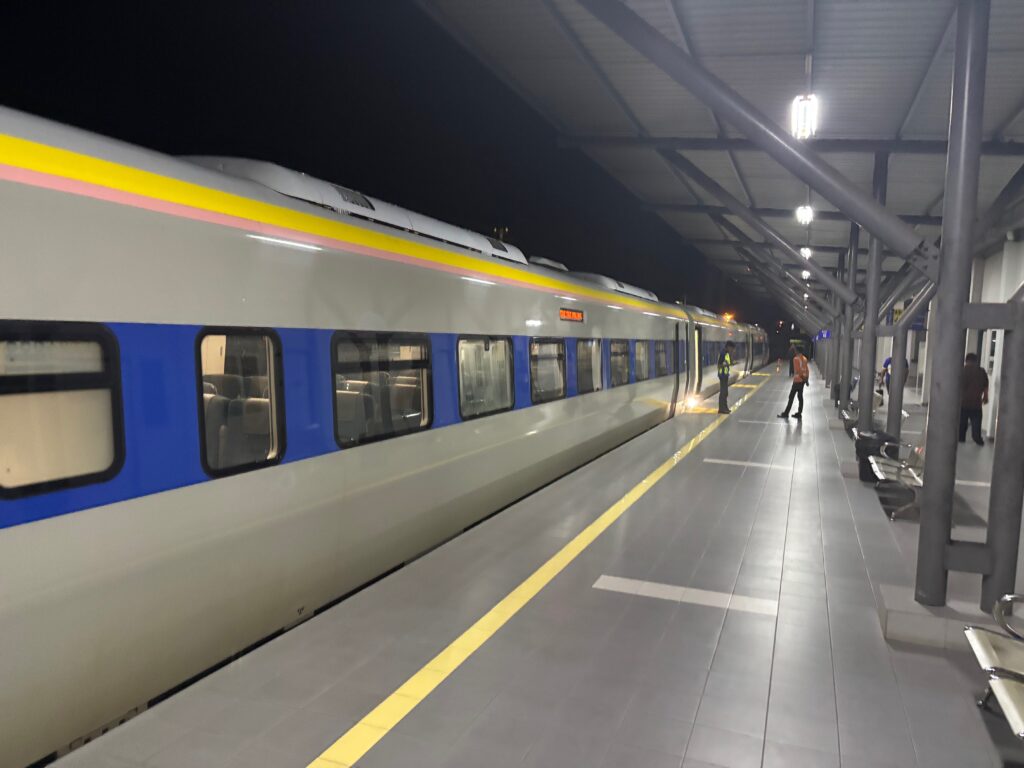
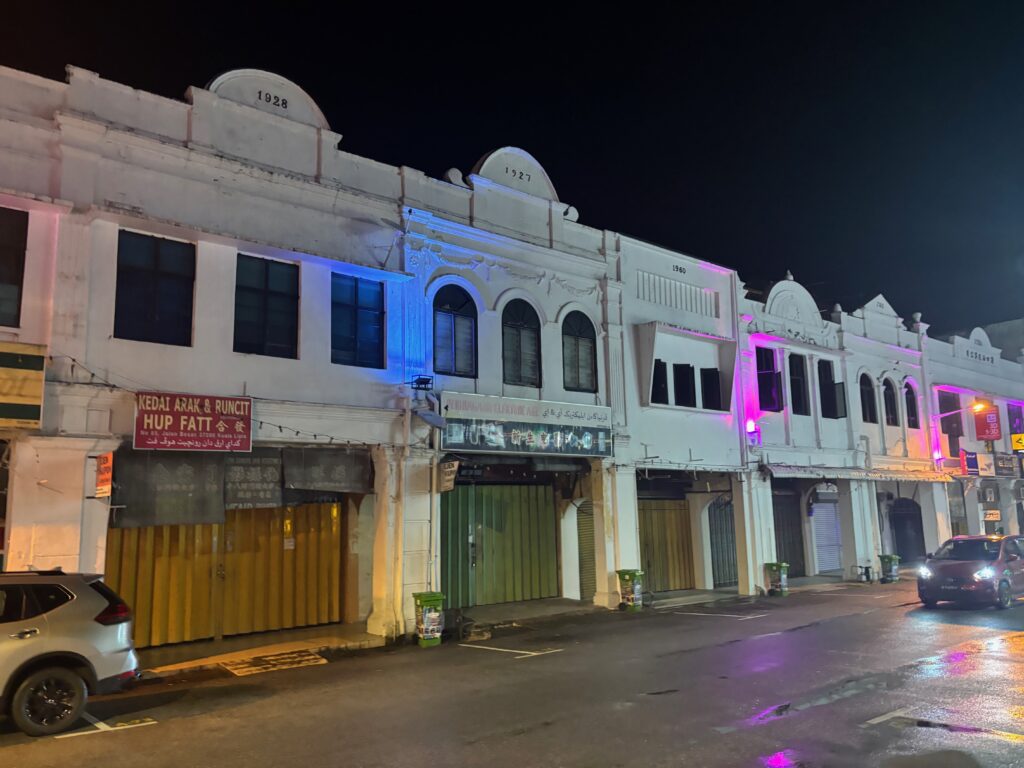
I walked from the station to my nearby hotel, enjoyed dinner at a nice restaurant, bubble tea at a cafe, and a browse in a book shop that stayed open until 10 p.m. before crashing for my early strat.
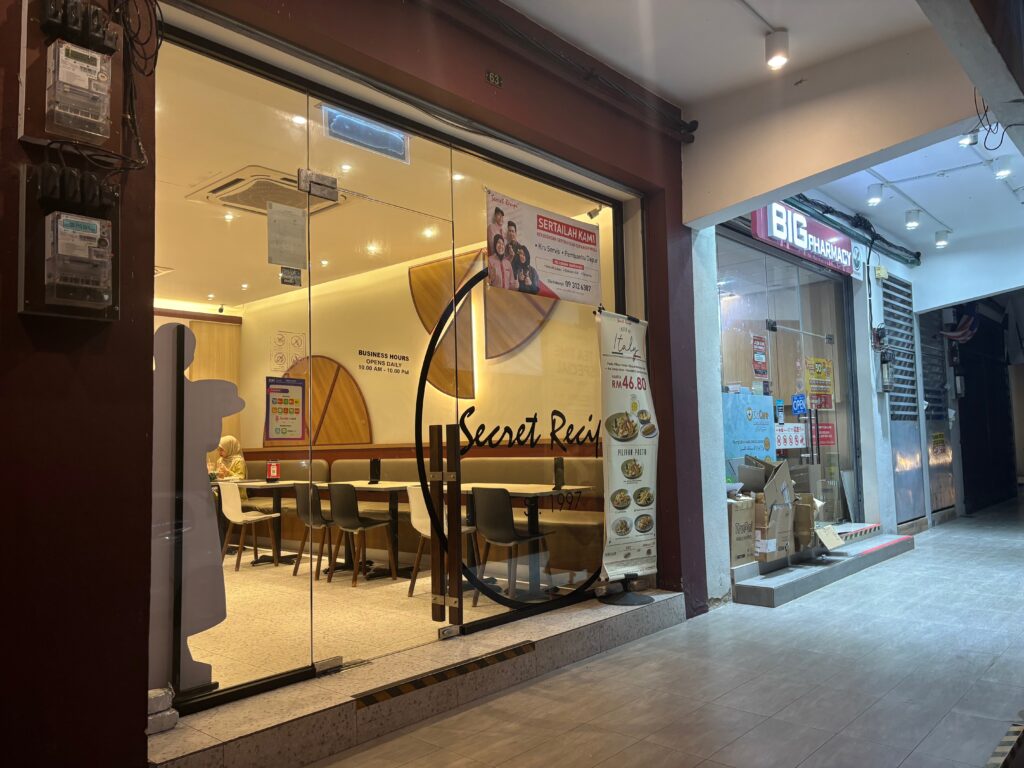
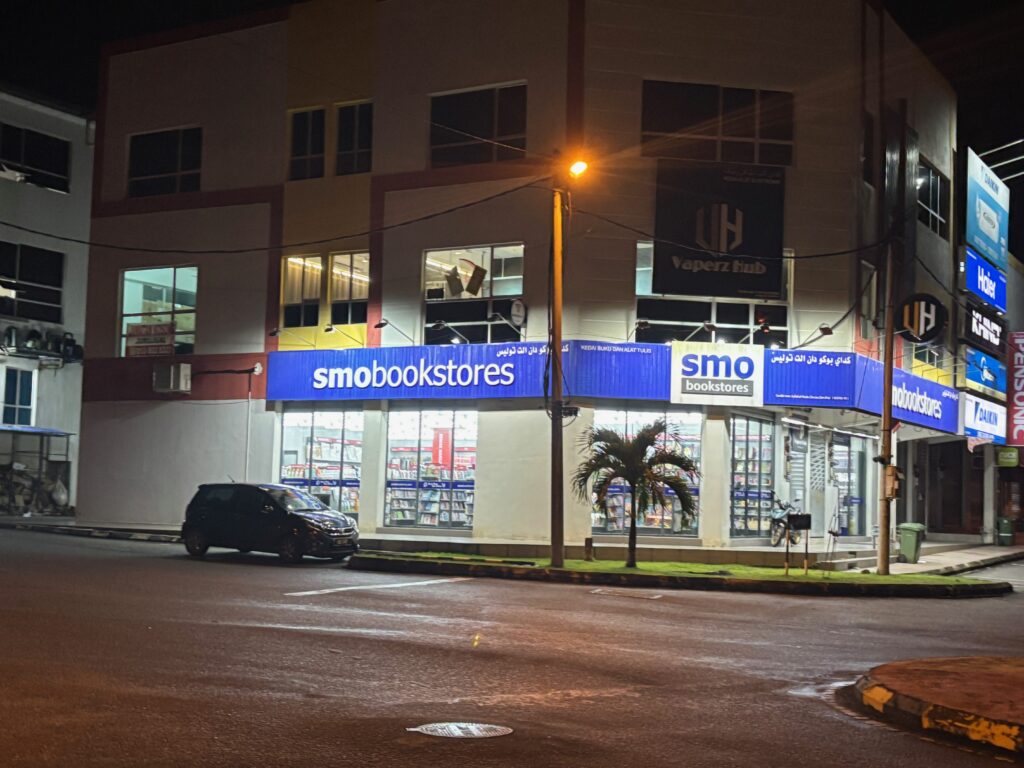
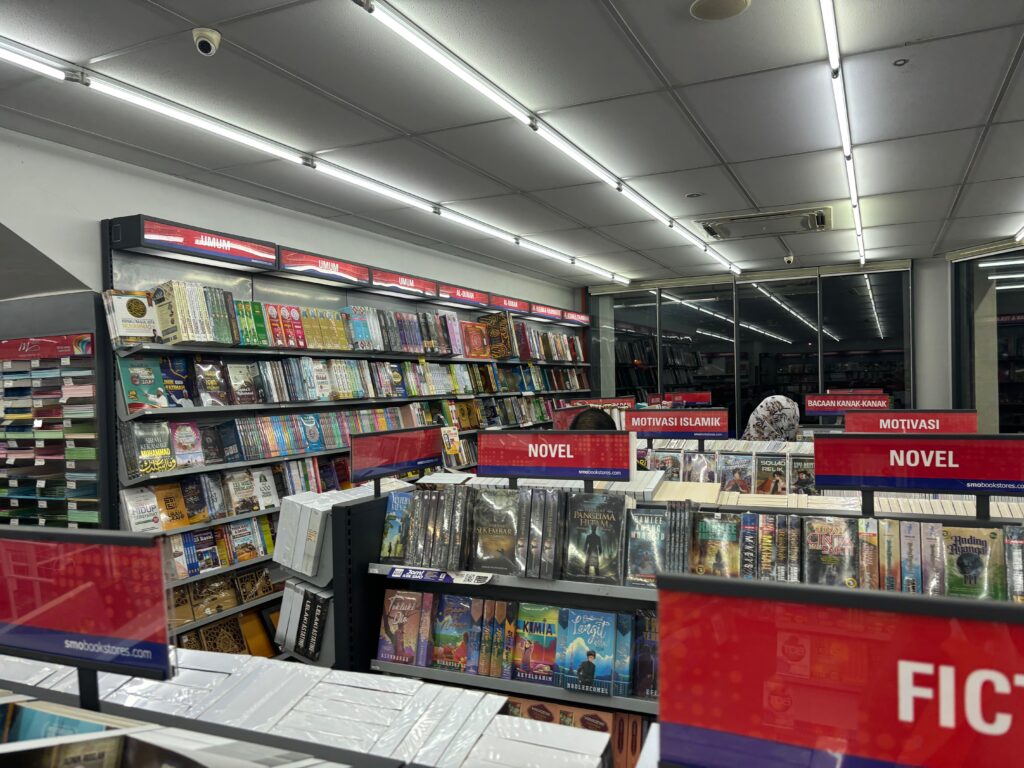
Second Train: The Older Model Sleeper Train
Woke up at 5 for the next part of my Jungle Railway ride on Malaysia’s East Coast Line- 330 km (200 miles) from Kuala Lipis to Tumpat— 6.5 hours. (Not a high-speed train!) After a quick walk through deserted streets, I arrived at Kuala Lipis station, where about half a dozen people were waiting. I was surprised when the 6:11 AM train arrived and departed right on time.
A staff member personally approached me to point me to my carriage, which was very kind. I was the only foreigner again, so it was obvious who I was! There were only two other foreigners on the rest of the ride.
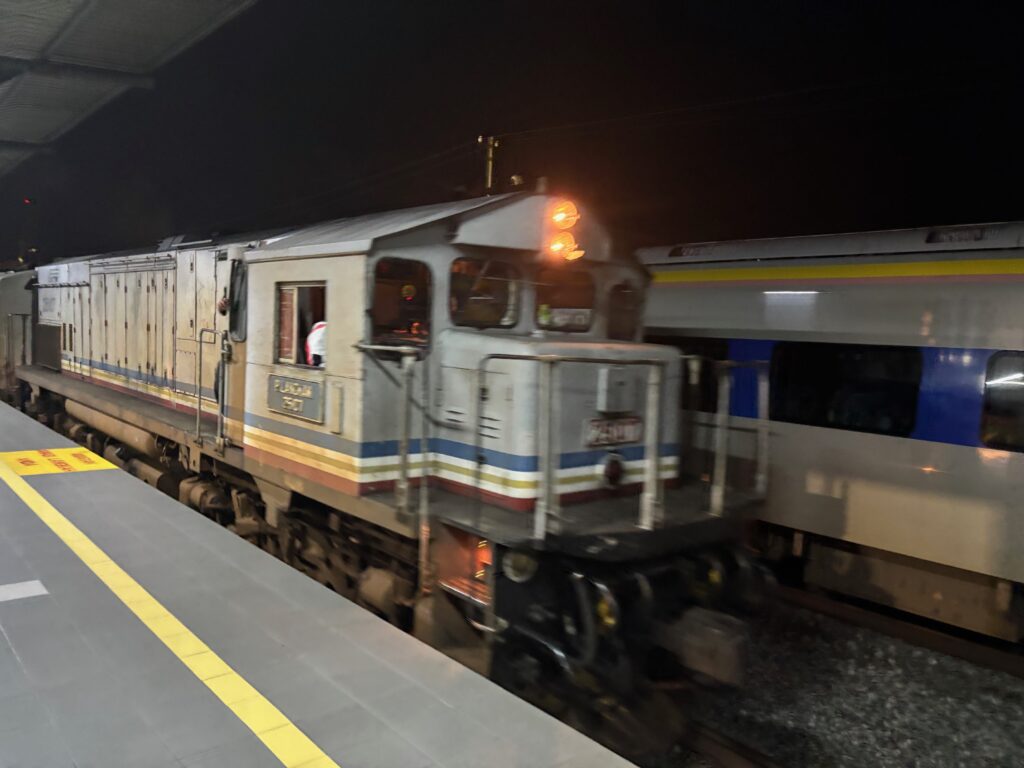
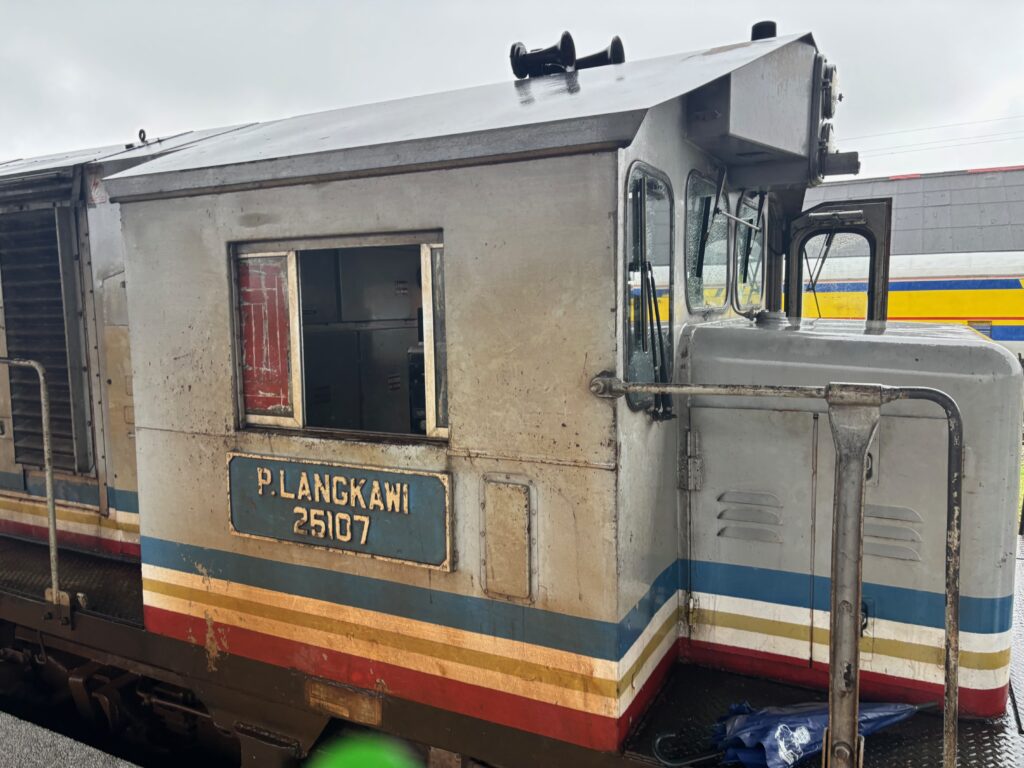
This train had eight carriages, including a generator car immediately behind the engine and then three sleeping cars, designed for the overnight trip from Johor Bahru..
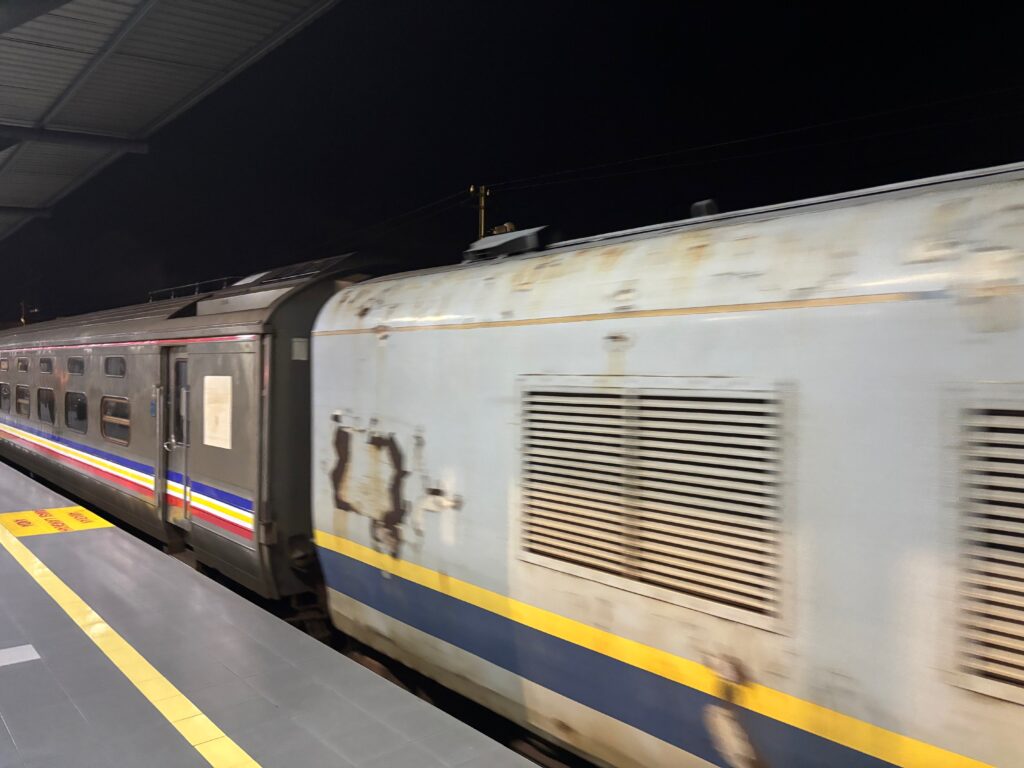
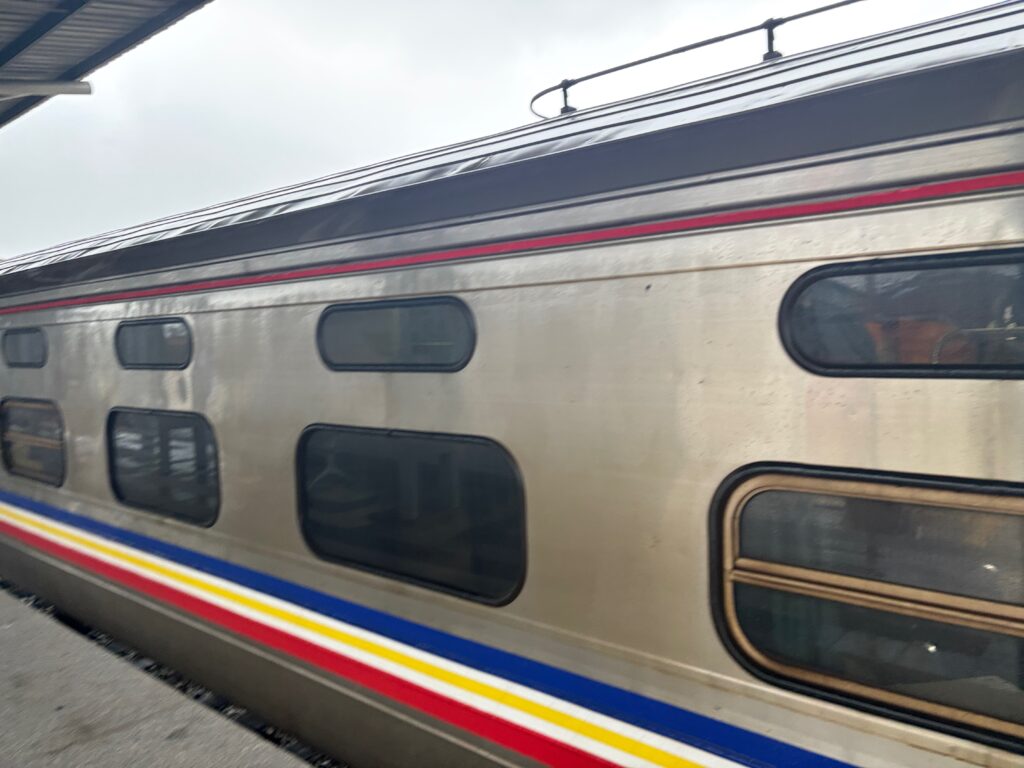
These carriages have bunk beds arranged in open bays, with two bunks stacked vertically in each section. Passengers are provided with basic bedding—a spotlessly clean sheet, pillow, and a blanket.
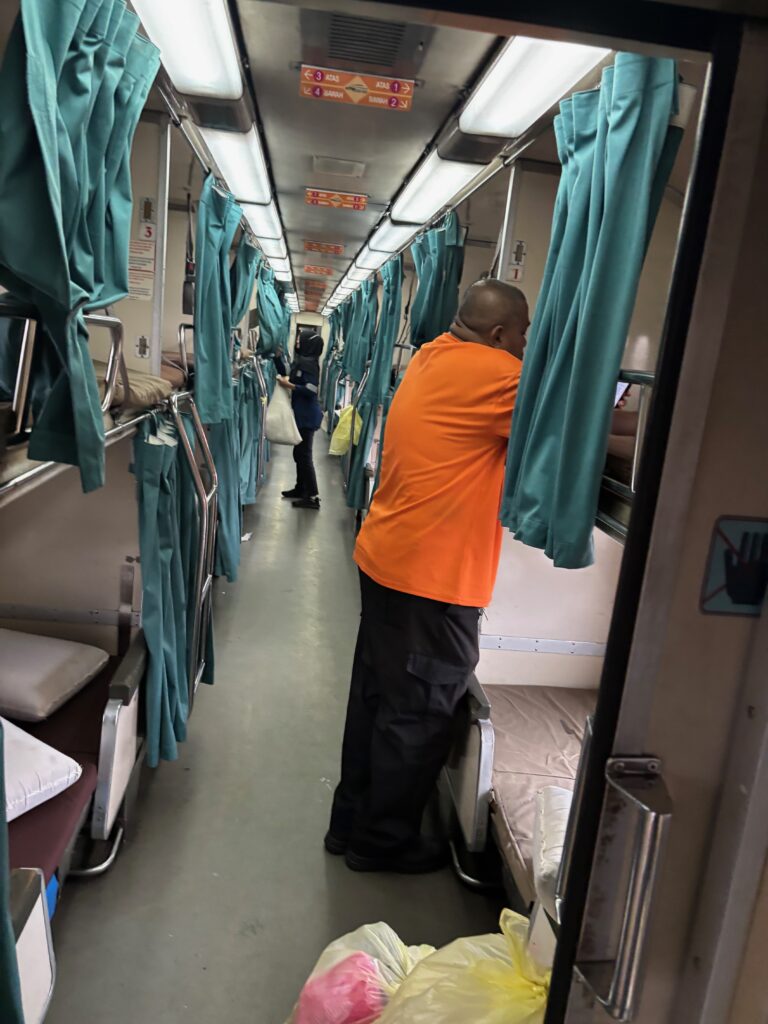
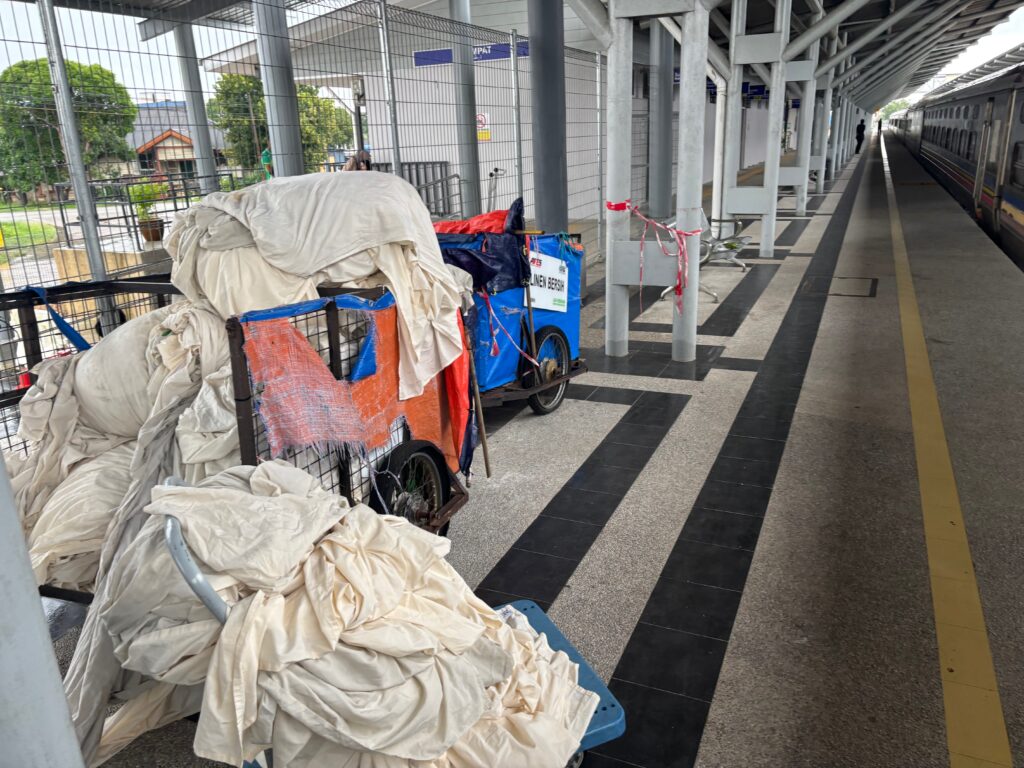
Next came a café car with a rather underwhelming selection of hot and cold drinks, simple snacks, and some meals. (NB avoid the coffee on board). It did have a great atmosphere and was a nice space to sit and watch the world slip by.
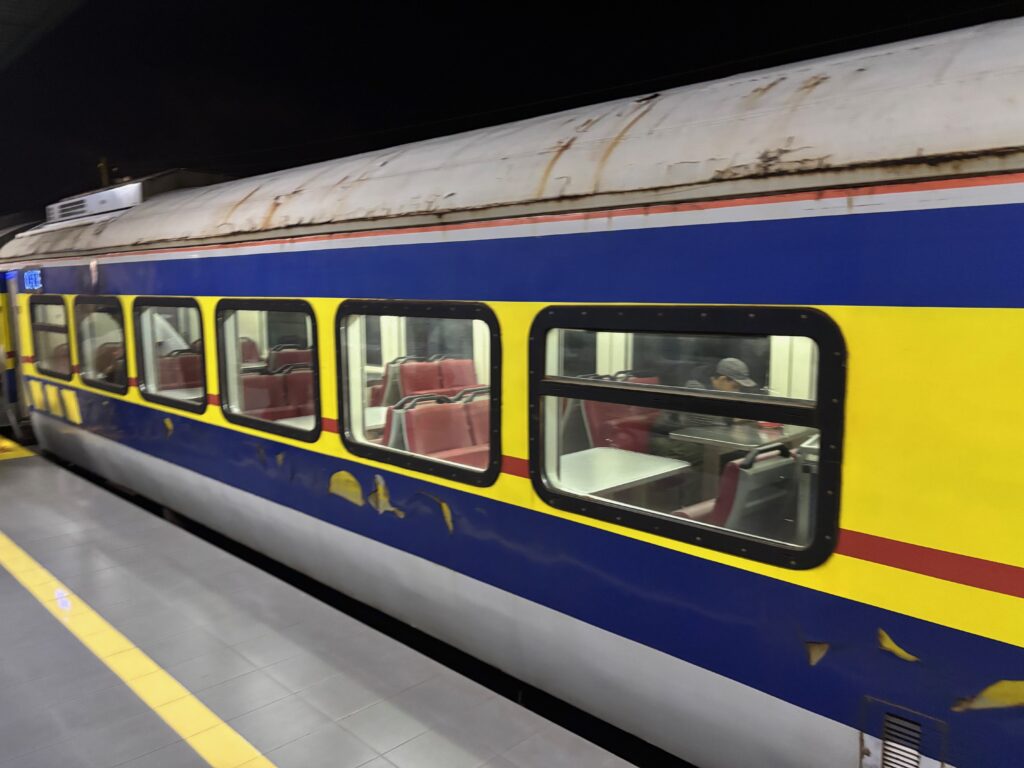
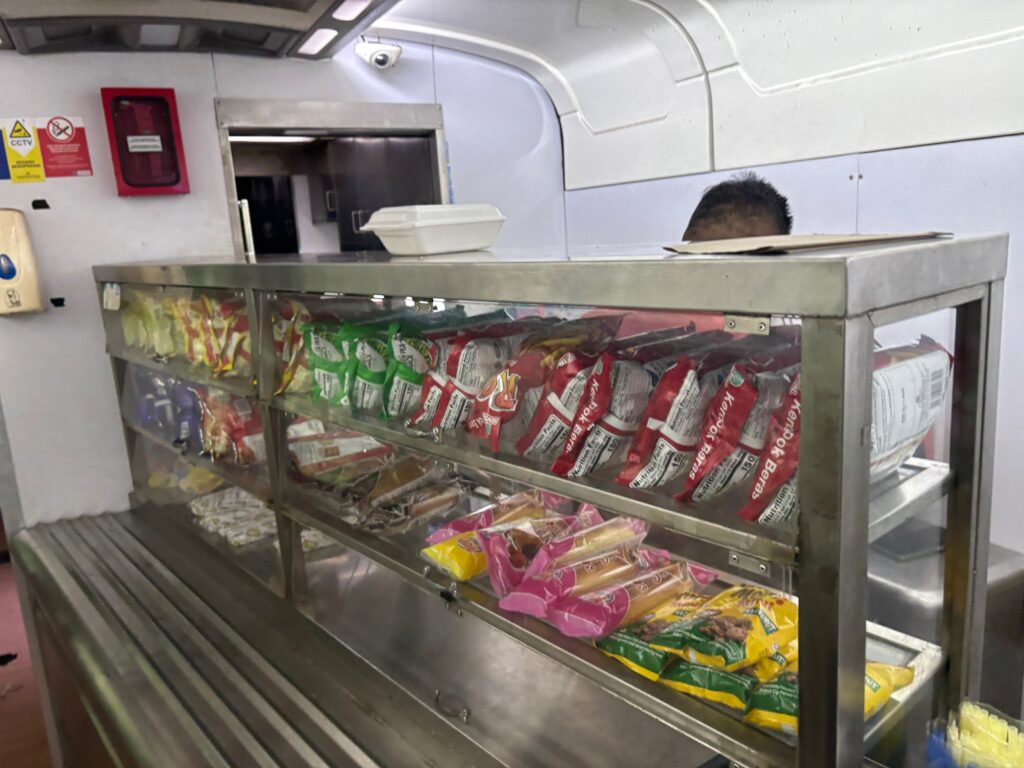
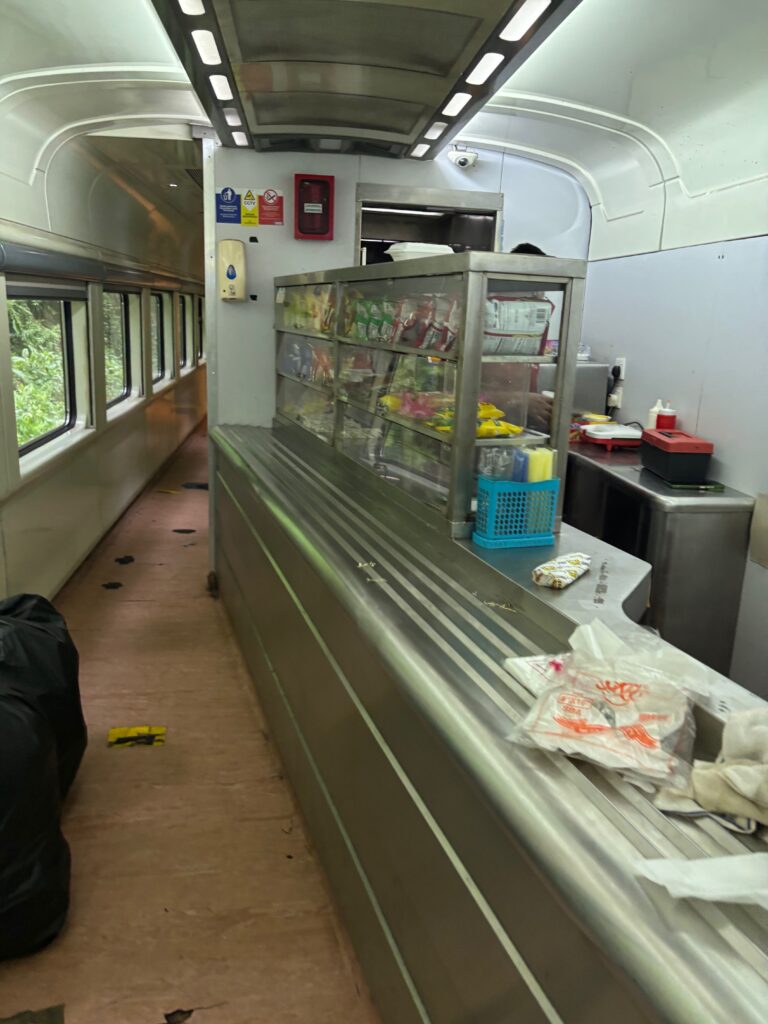
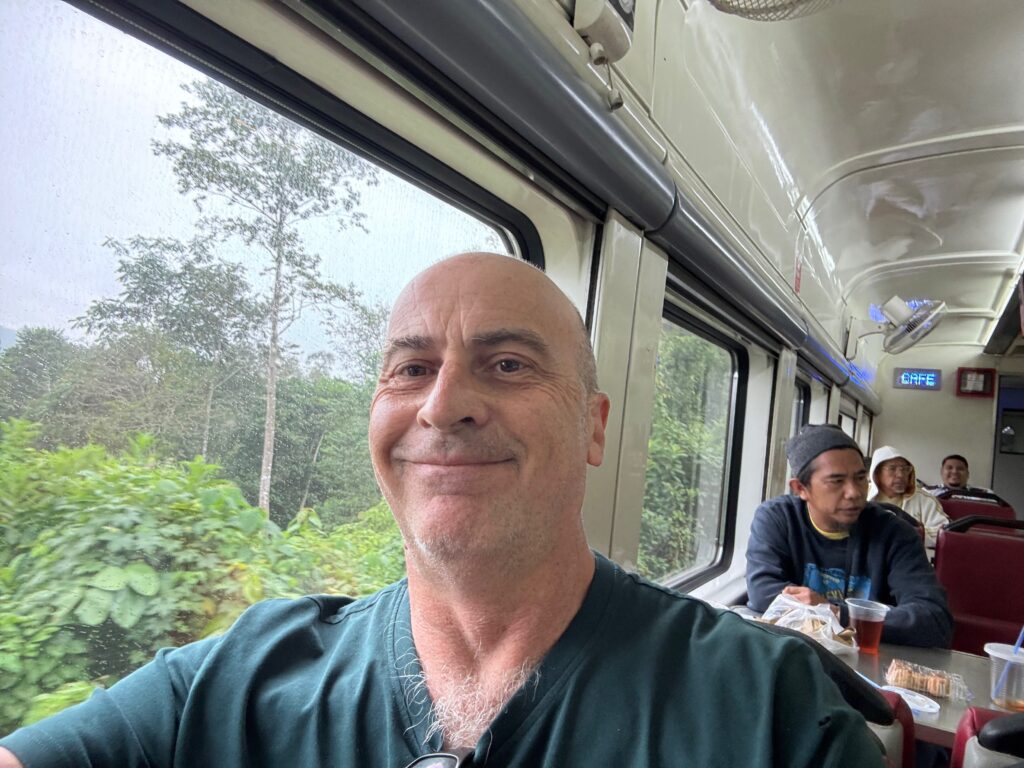
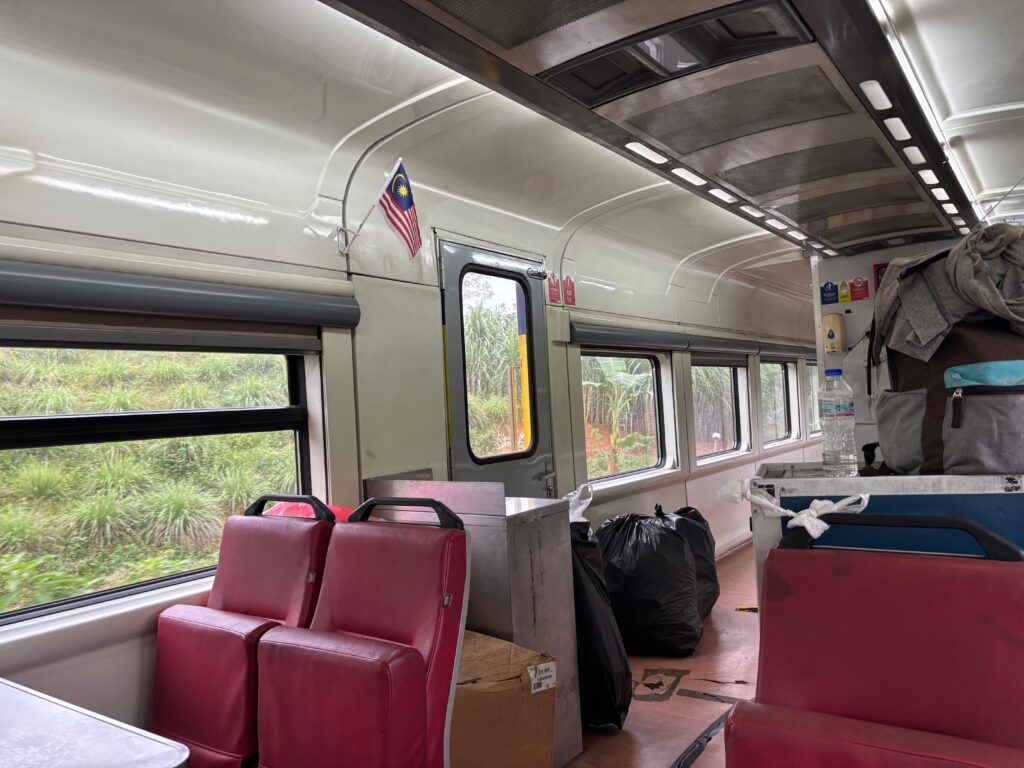
Three ordinary class carriages with seats 2/2 across came next. They were perfectly comfy!
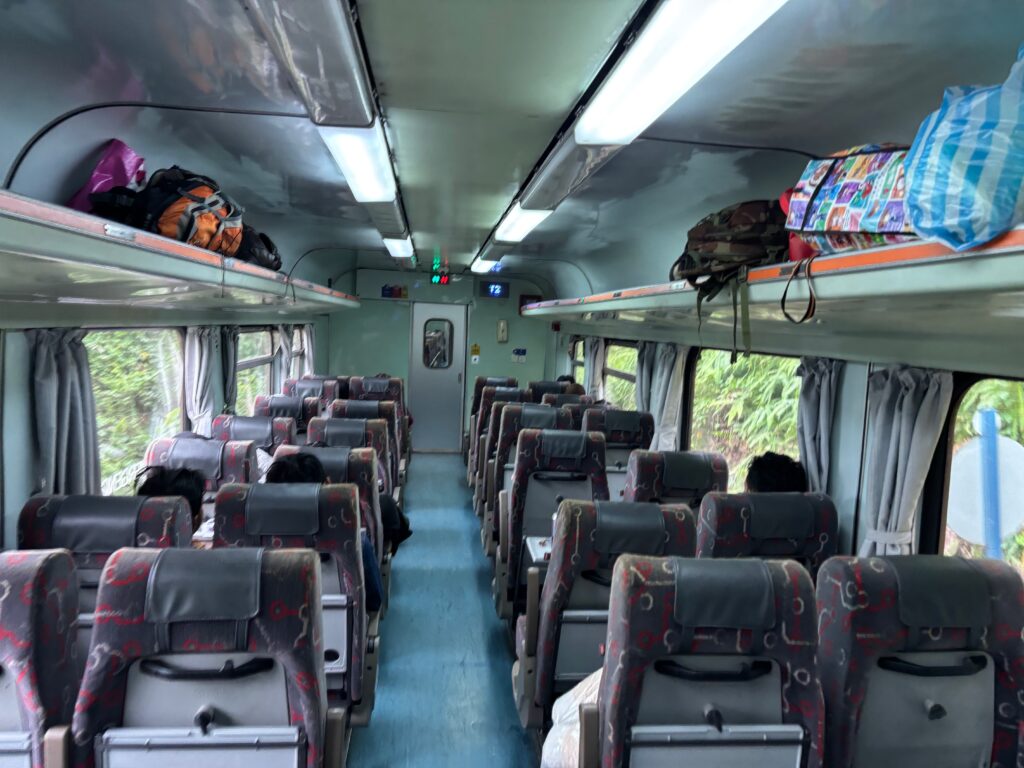
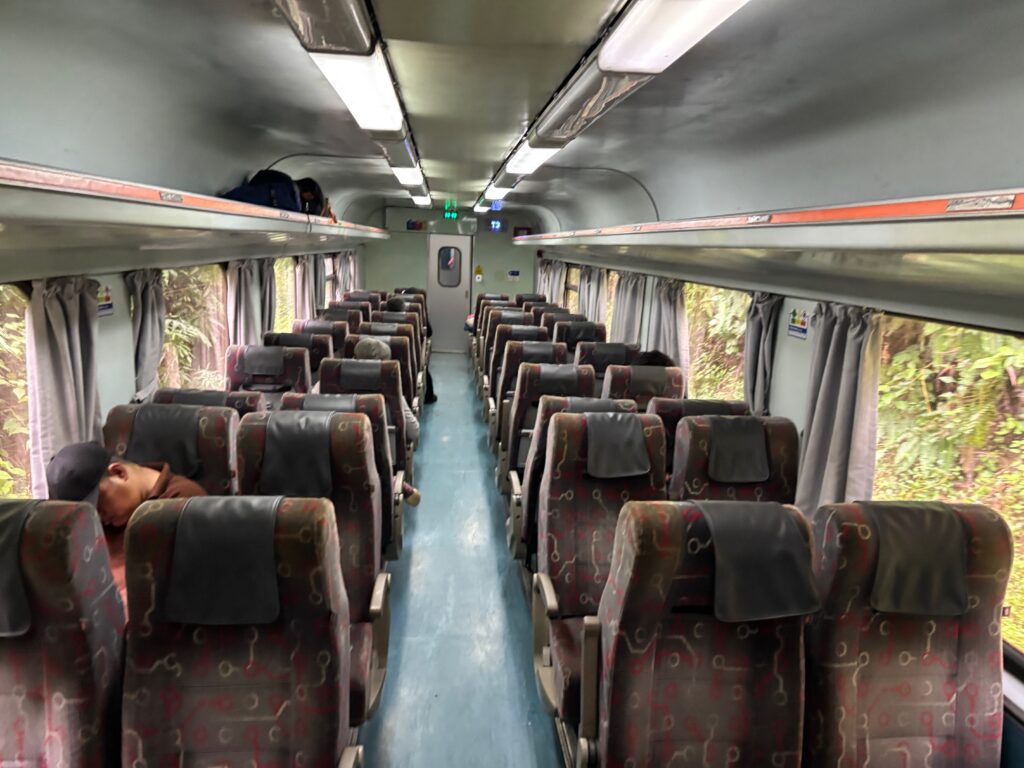
The last carriage is reserved as a premium seater, with 1/2 across and padded reclining seats with more legroom. This carriage feels dated, with older fixtures and a somewhat worn appearance, but was still cozy to sit in. The train’s retro charm and utilitarian design added to the sense of adventure and nostalgia, giving passengers a glimpse into a rapidly disappearing era of train travel. There were two power outlets in the carriage, which we passengers amicably shared.
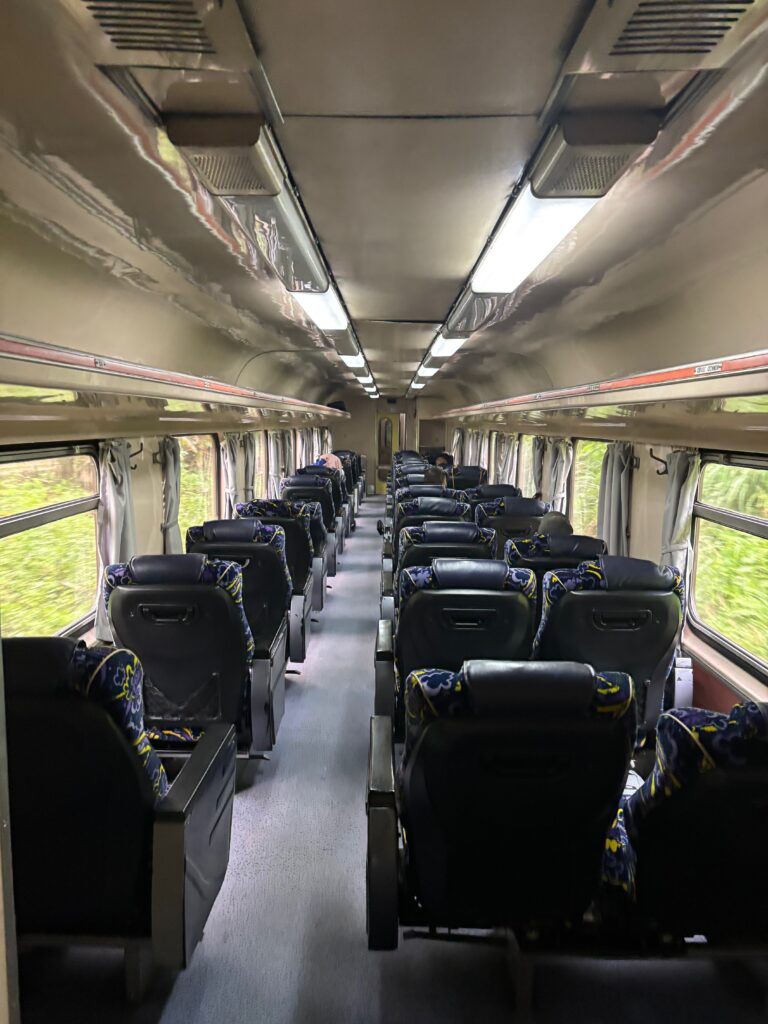
Finding my seat 1A was easy, and I quickly settled in. The fare for my ride was 53 MYR ($12 USD), while the economy class was around $6 USD.
Despite the early hour, the person behind me in seat 2A was playing videos and having loud chats with her friends on speakerphone. As the signal was intermittent, she would get cut off, and then her friends would call back—leading to her phone continually ringing with a very loud ringtone! I politely asked her to turn the volume down twice. I think she felt this was probably an unnecessary fuss by a foreigner. I eventually nodded off and woke up as she got off at the next station.
The train offered both squat and seated toilet options, complete with working bum guns. The onboard toilets were functional but a bit grim. The cleaning crew checked in regularly, and they were clearly being updated. However, the station toilets and those on my earlier trains were much more pleasant.
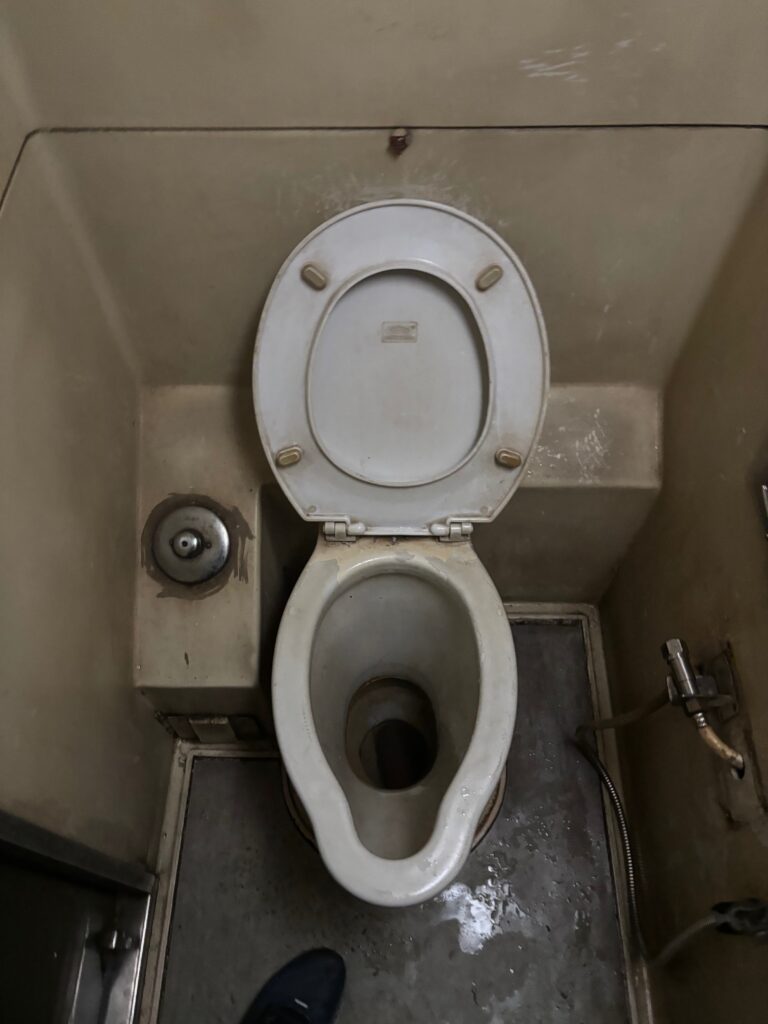
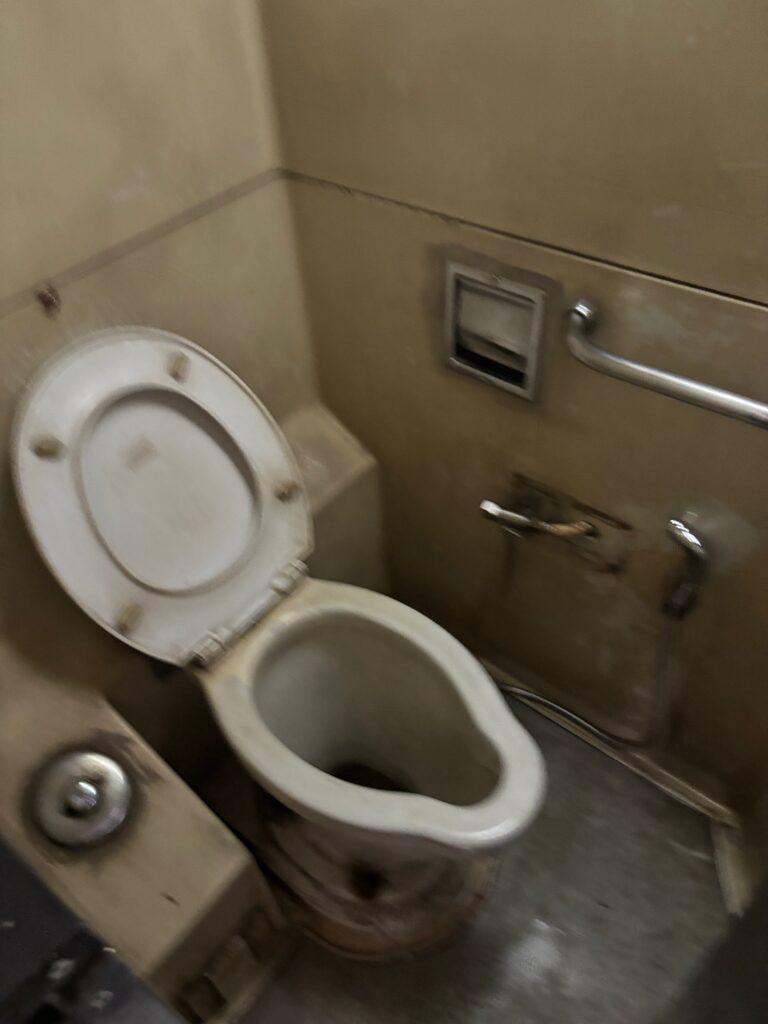
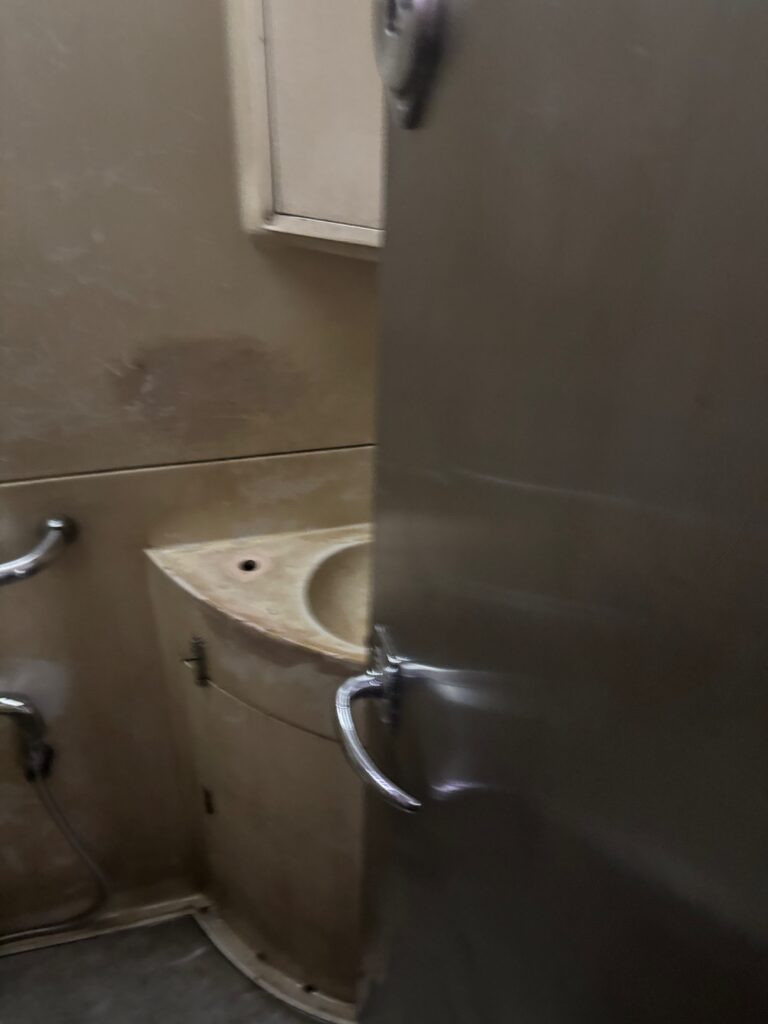
Along the line
In contrast to the toilets, on the second leg, from Kuala Lipis to Tumpat, (about a six and a half hour journey), the Jungle Railway offered breathtaking views from the large, expansive, and very clean, windows I got to see the small hamlets, the bigger towns, the old stations, and of course the jungle, with its trees, dense forest, and towering limestone formations, mountainous terrain and several rivers, including the Sungai Pahang.
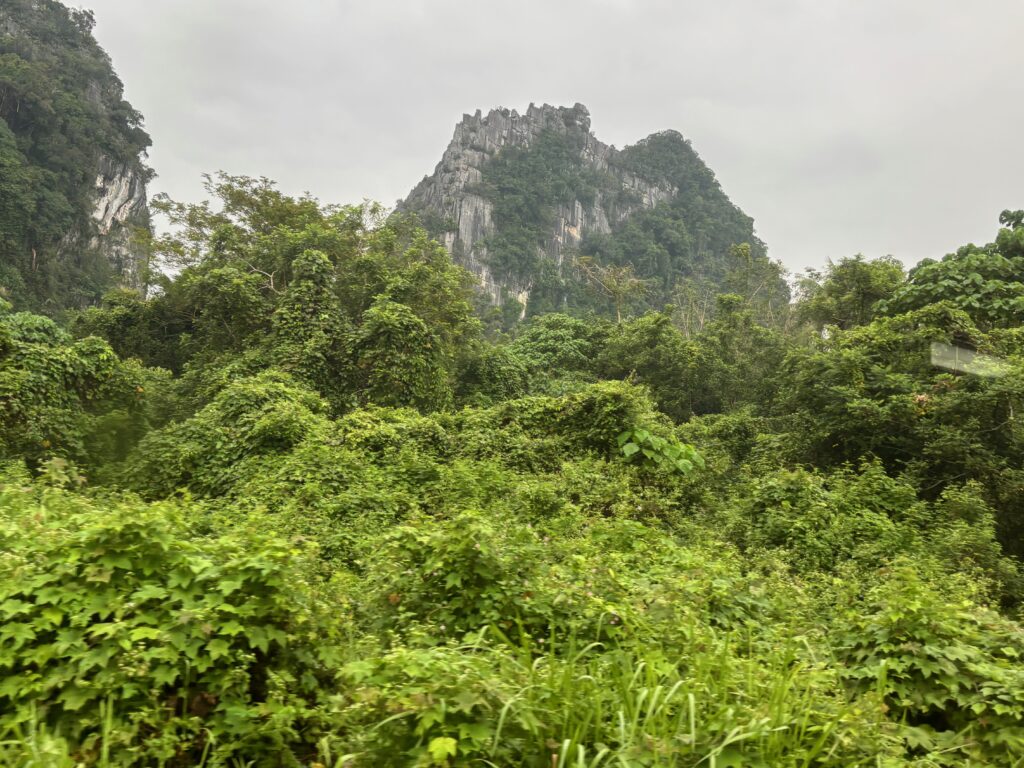
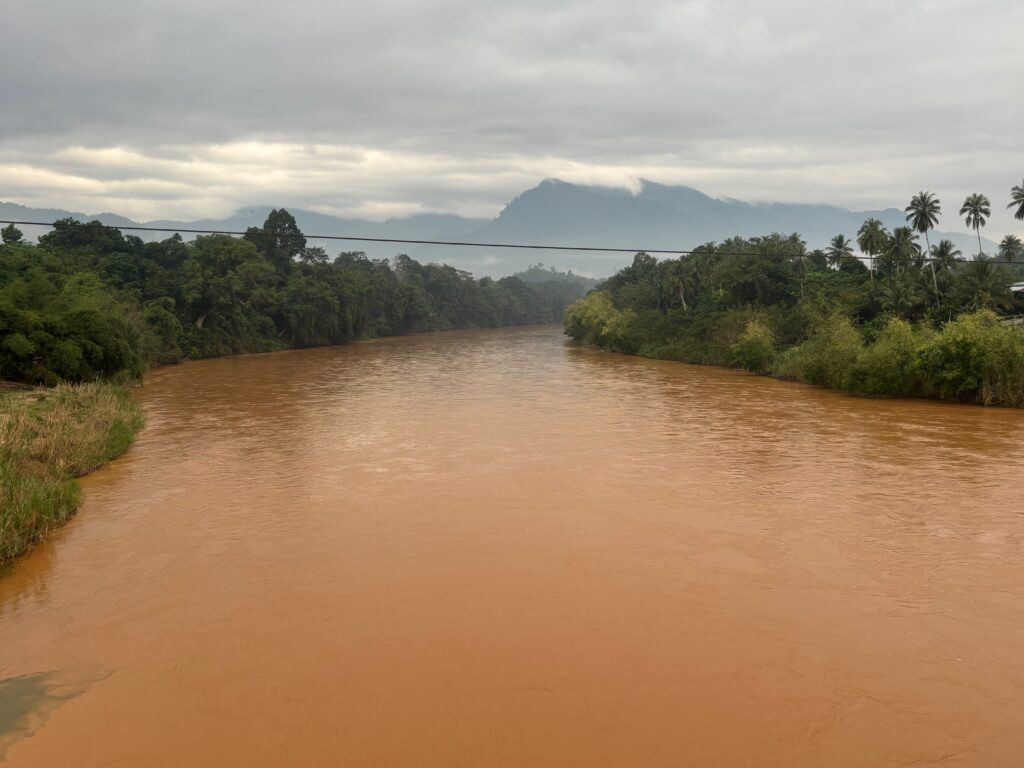
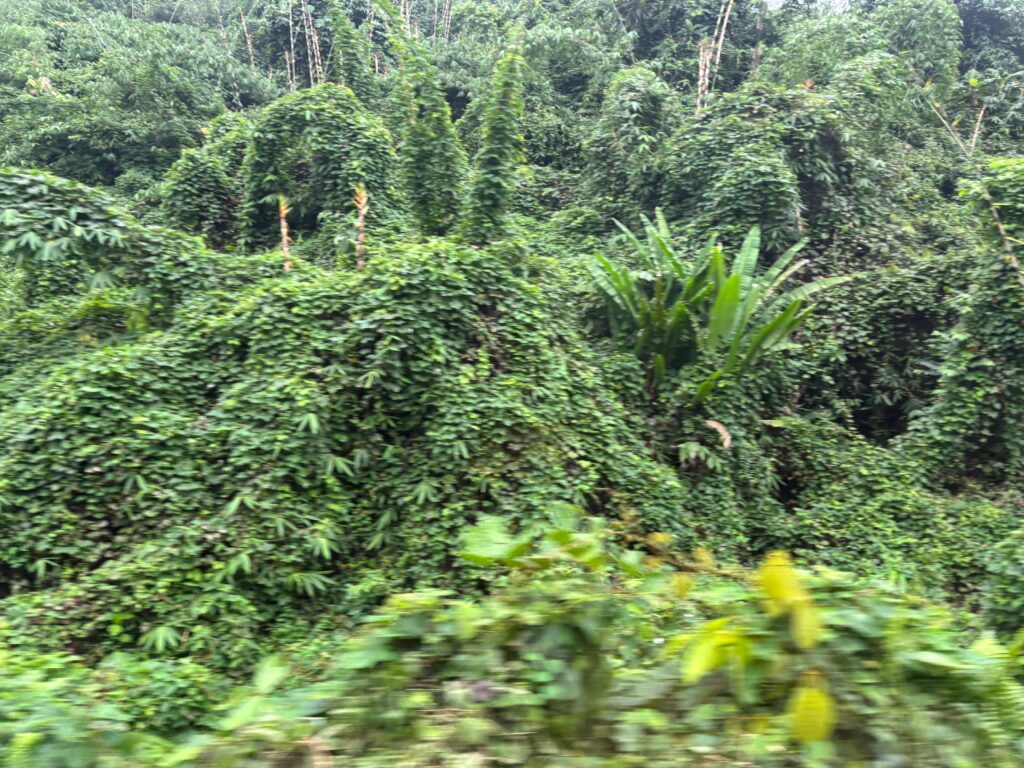
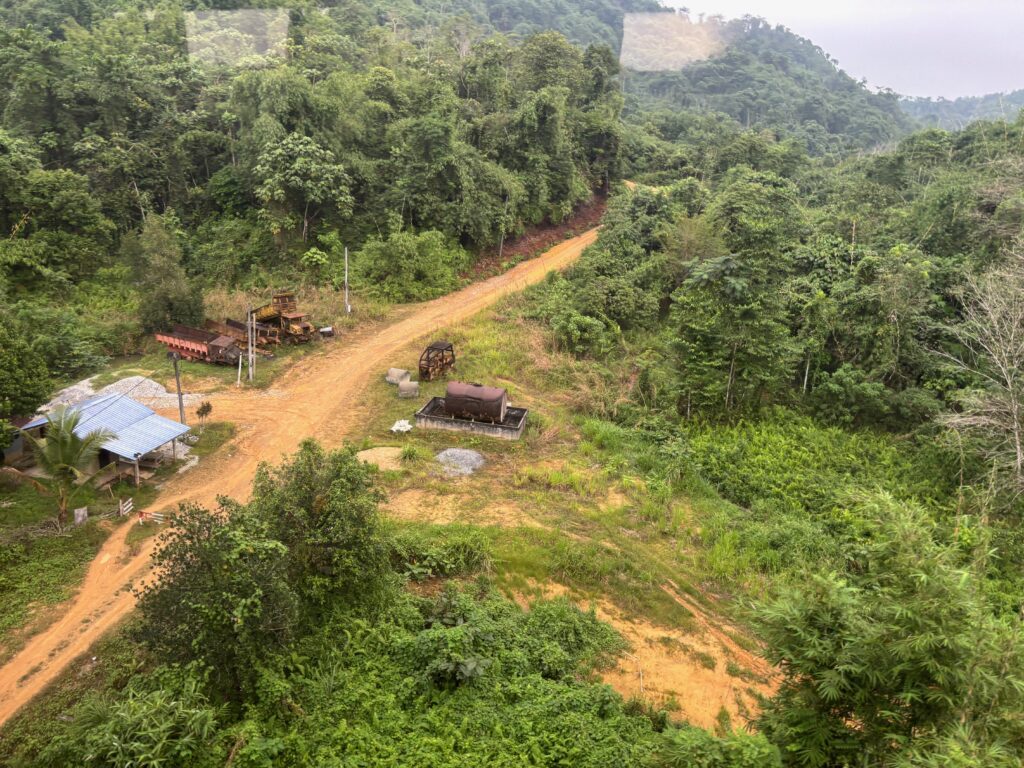
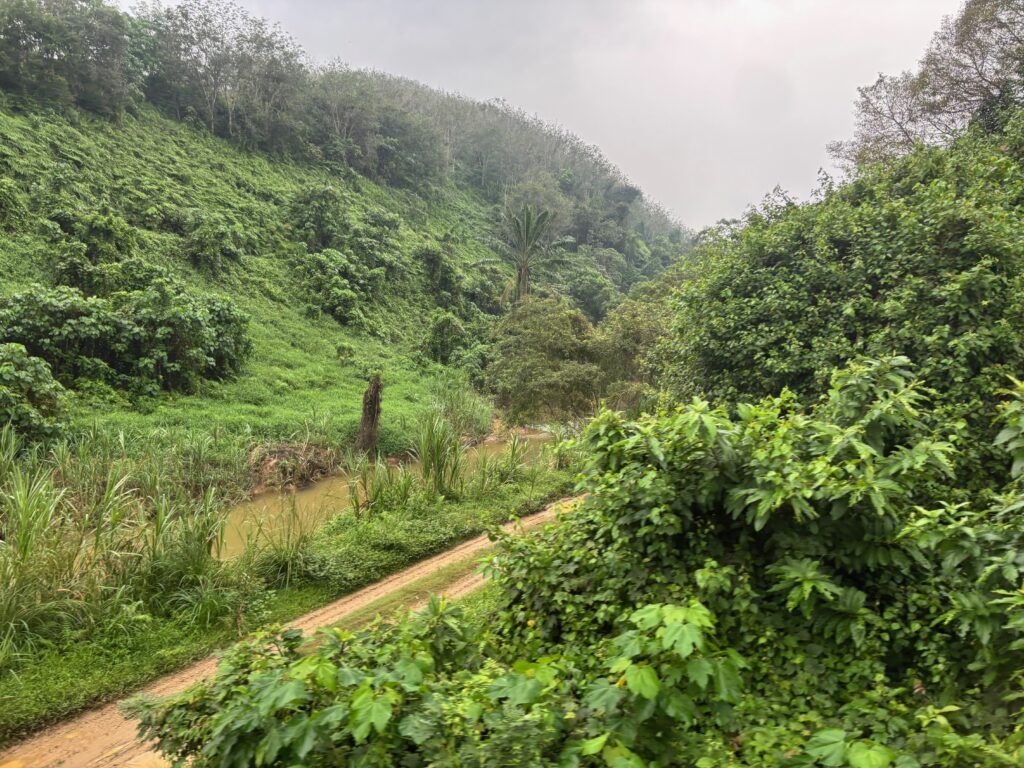
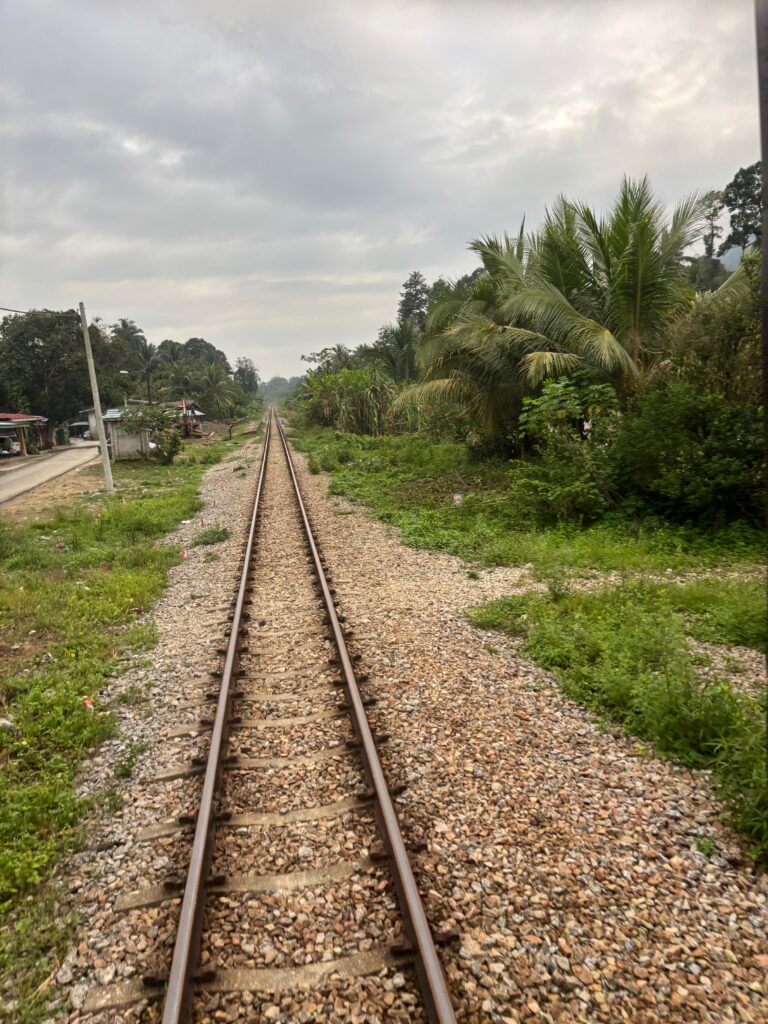
The ever-present palm oil plantations—steadily encroaching on Malaysia’s jungles—were also a frequent sight.
Along the way, glimpses of daily life unfolded outside the windows: children heading to school, workers commuting, families enjoying brunch, and villagers tending to their land.
The landscape was also dotted with animals—for example, cattle grazing by the tracks, dogs running free, and, unfortunately, no sightings of anything too exotic, but plenty of birds.
Station Stops
We stopped at:
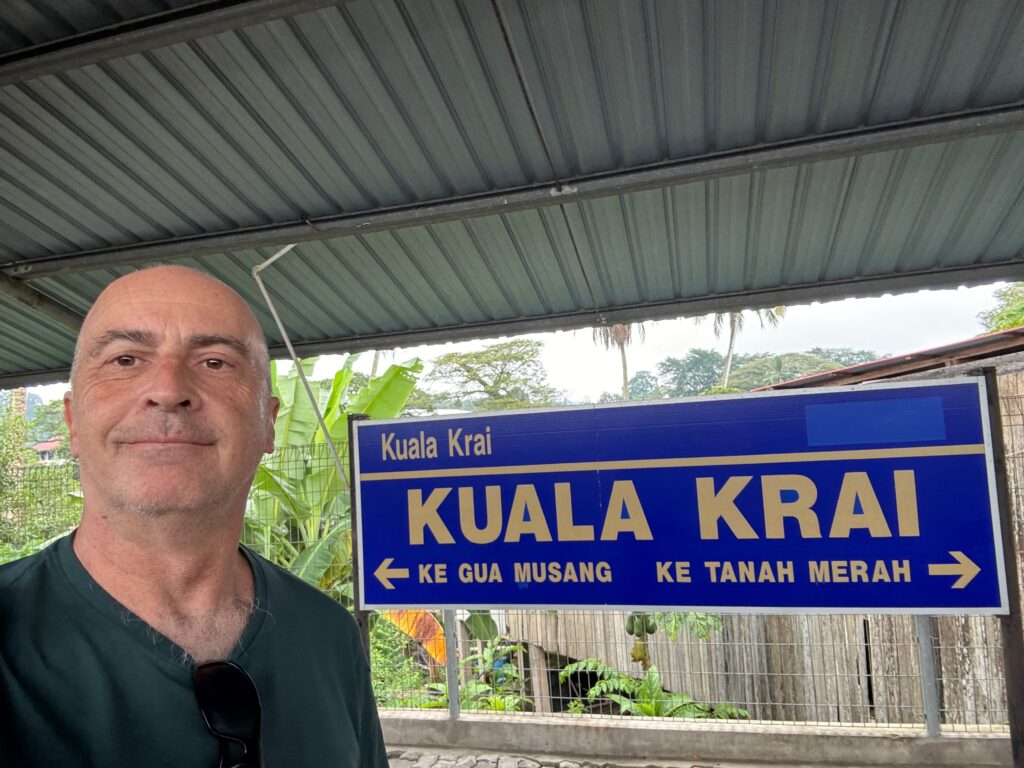
- Chegar Perah – 260 km
- Merapoh – 290 km
- Gua Musang – 320 km Famous for its limestone hills and caves.
- Limau Kasturi – 350 km
- Kemubu – 380 km
- A small but significant town, Dabong (400km) is a popular stop due to its proximity to natural attractions, including limestone hills, caves, and lush rainforests, the Gunung Stong State Park and the Jelawang Waterfall, one of the highest waterfalls in Southeast Asia. Much of the train got off here. We stopped for a long time at Dabong for a train travelling in the opposite direction, as this station serves as a passing point along the single-track railway. During this longer stop, we passengers stretched our legs and chatted. Many, including staff, grabbed snacks from a local cafe opposite the station.
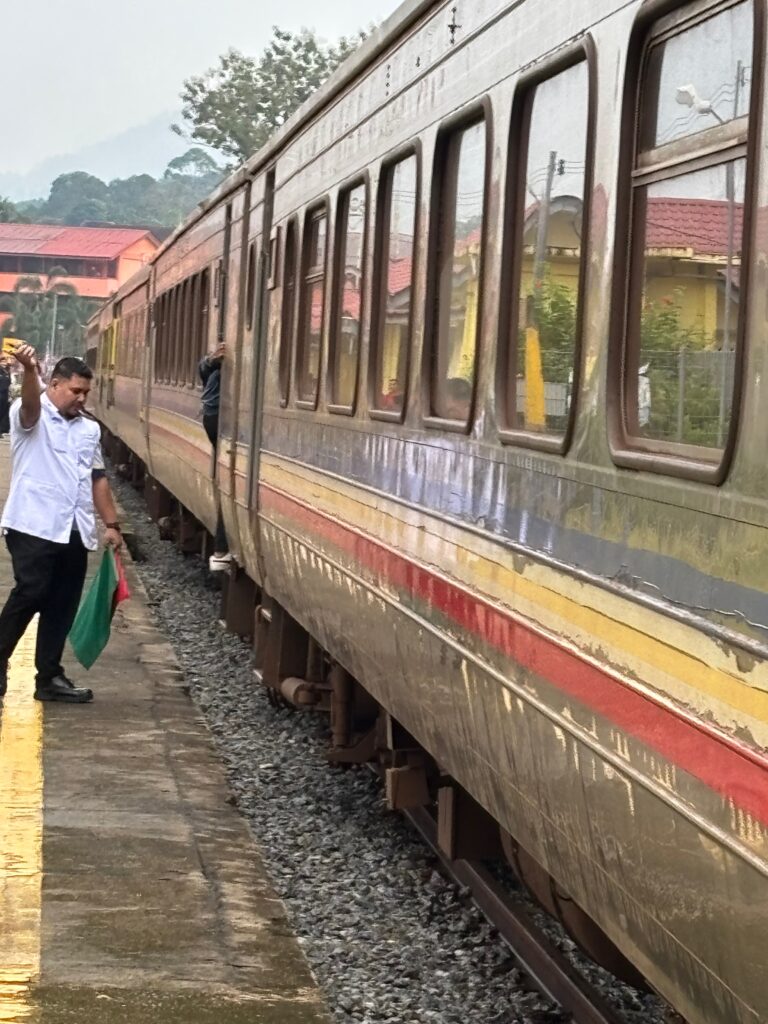
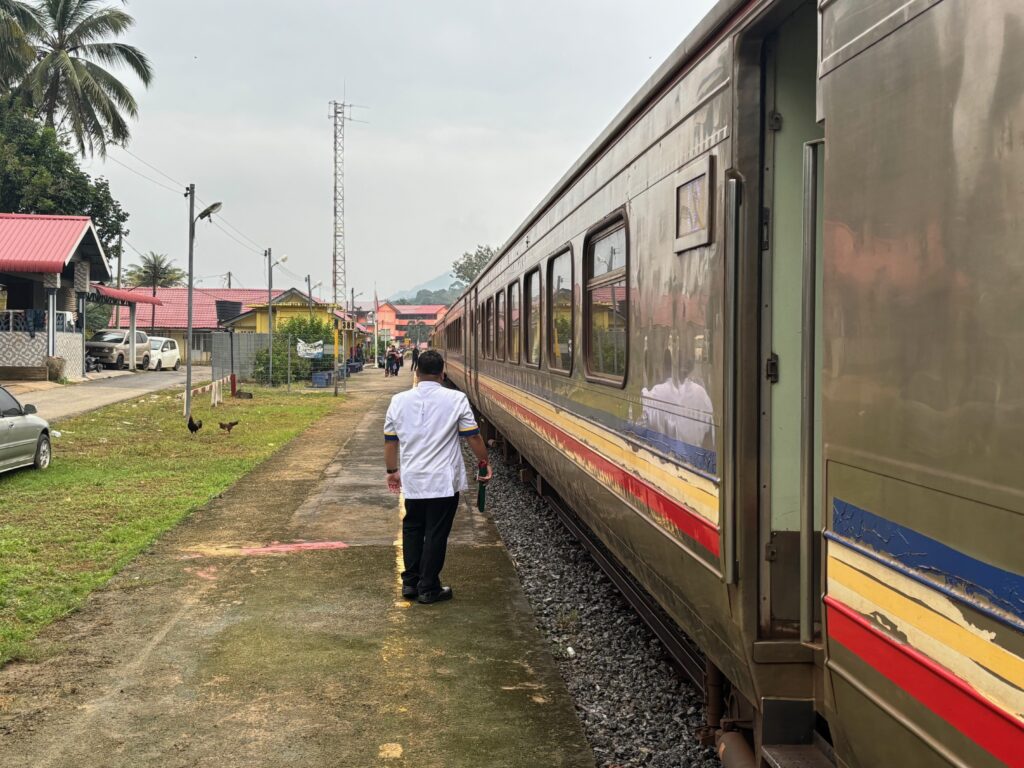
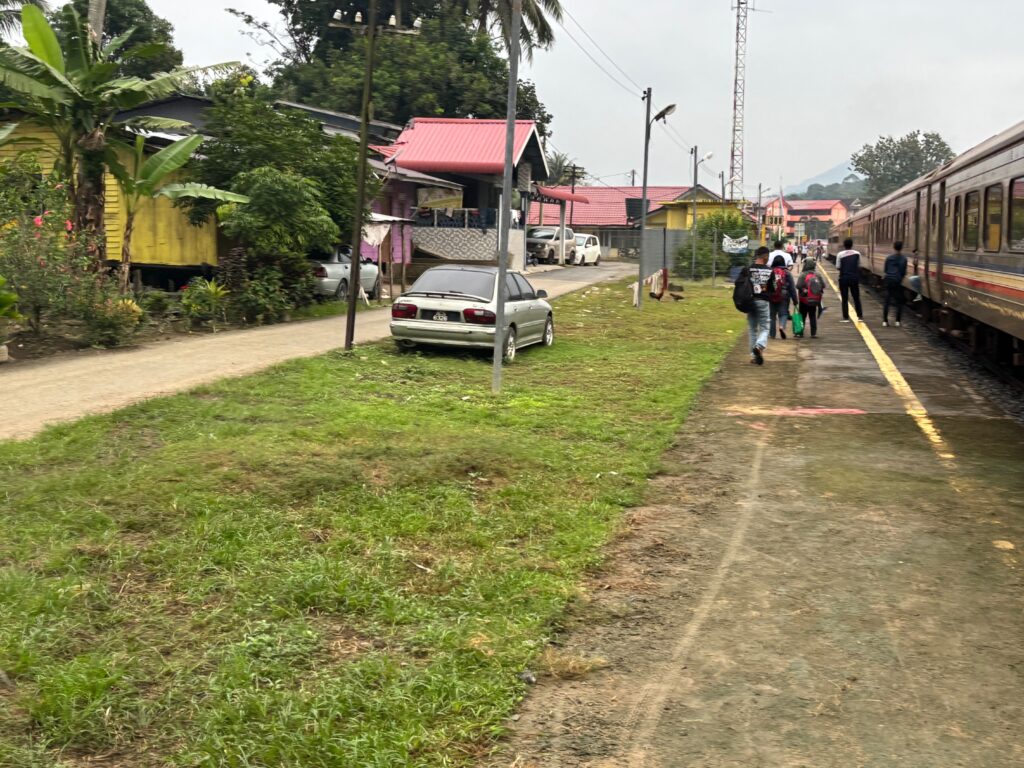
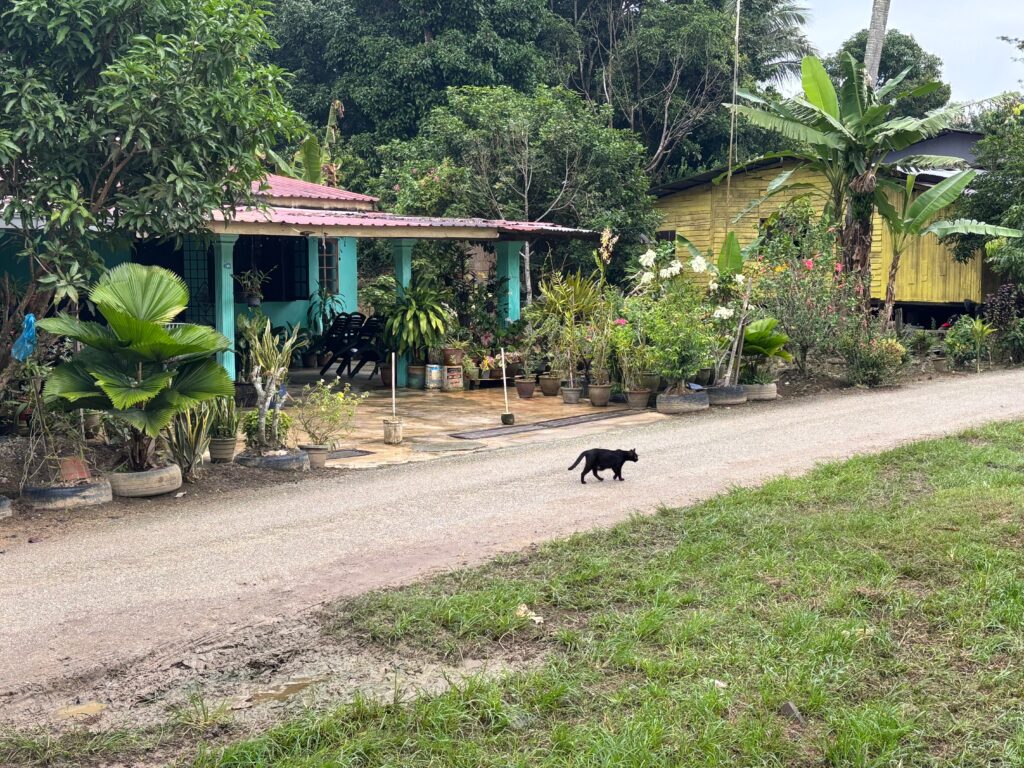
Blink and you’ll miss these stations, but for locals, they’re essential for daily life:
Temangan – 500 km
Bukit Abu – 430 km
Manek Urai – 450 km
Kuala Krai – 470 km
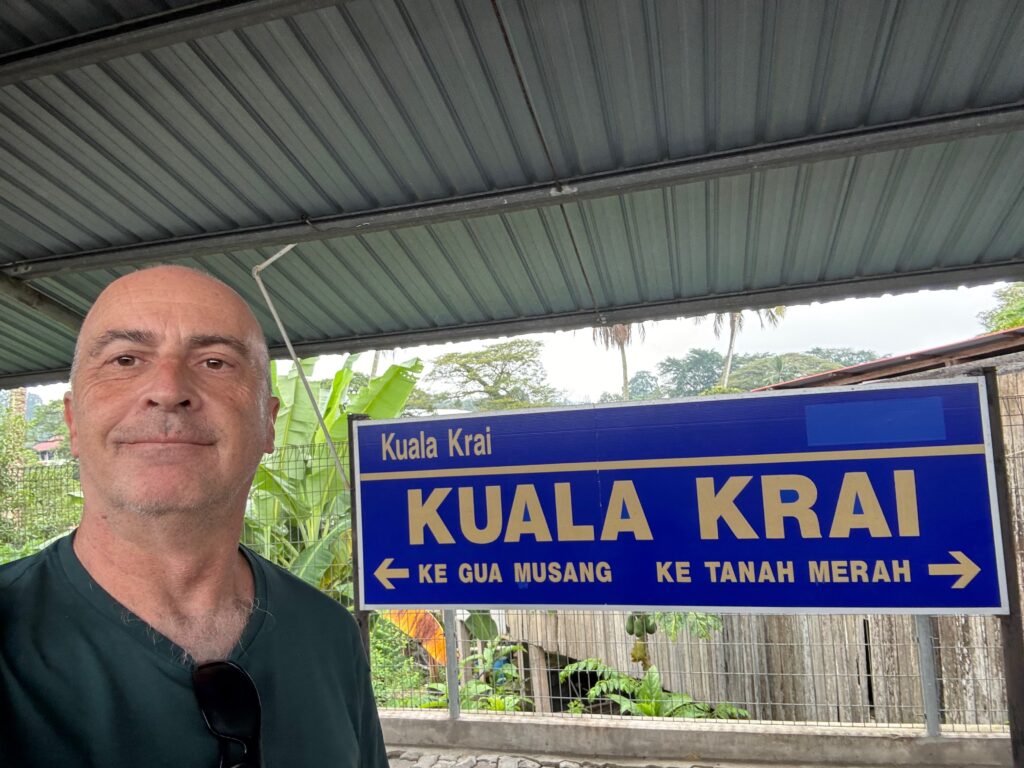
- Tanah Merah – 520 km The last big stop before the border region, where the train starts to empty.
- Pasir Mas – 540 km, A bustling market town near the Thai border. Lots of people disembarked here
- Most passengers had disembarked at Wakaf Bharu:station (550km), the stop 11 km before Tumpat. It is the nearest station to the state’s capital Kota Bharu. I stayed on just to say I’d done the full journey! The woman at my hotel laughed when I told her this, noting that there had been an increase in foreign tourists visiting specifically to ride this line. I don’t think she quite understood the attraction of an old, slow railway!
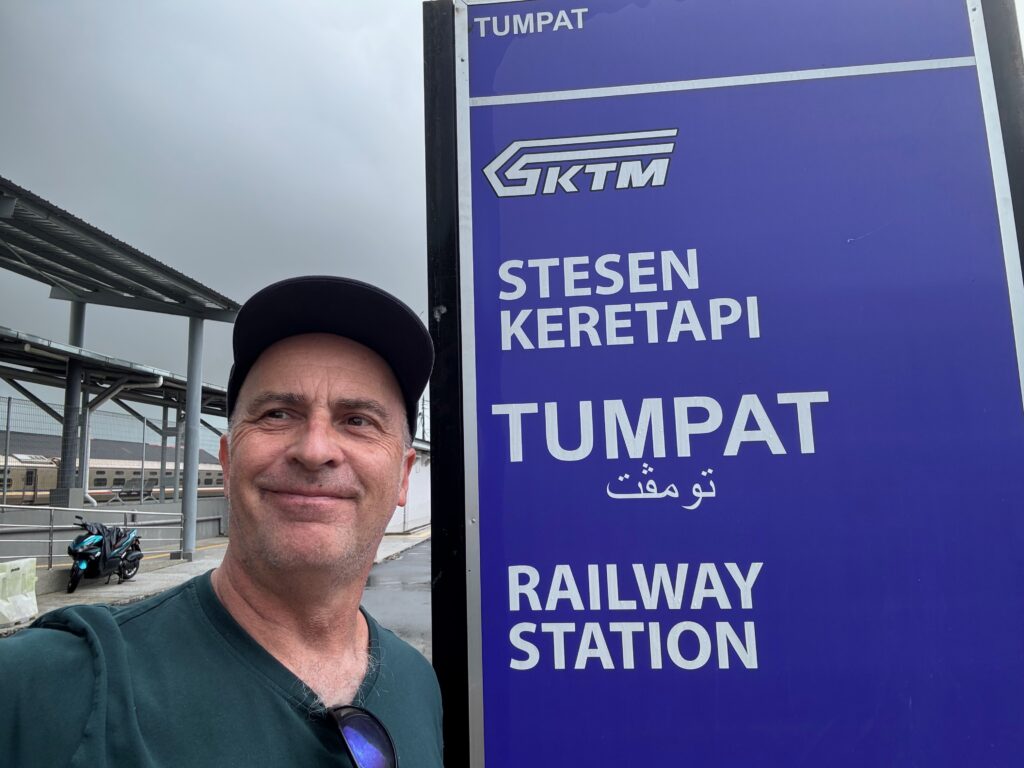
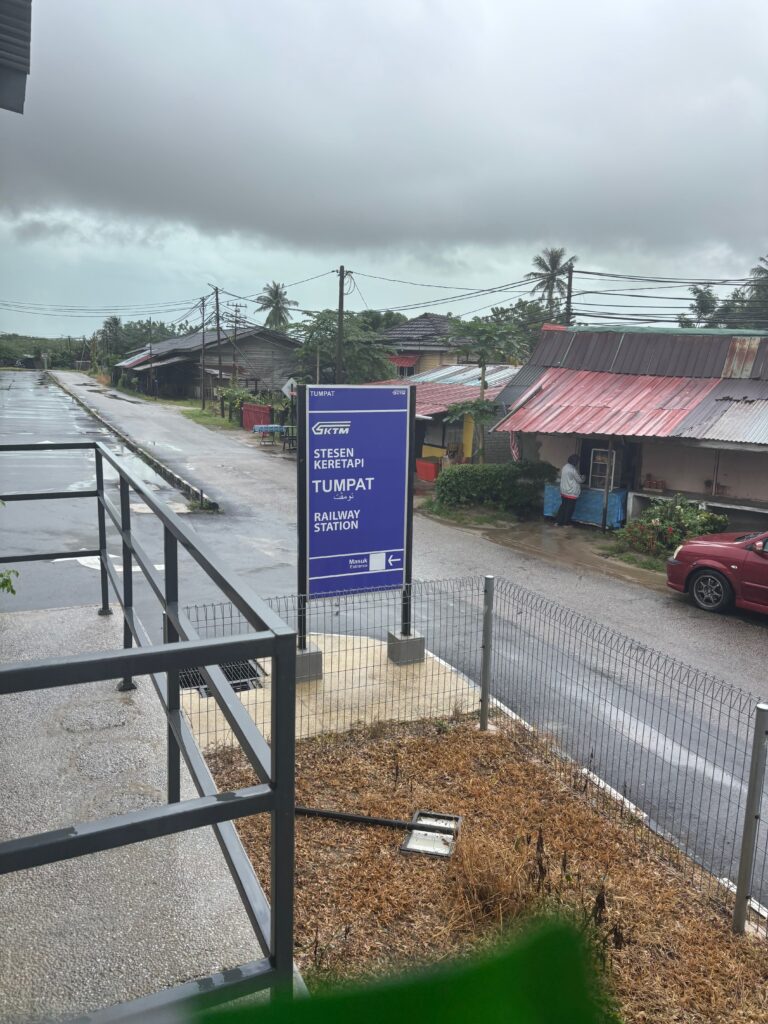
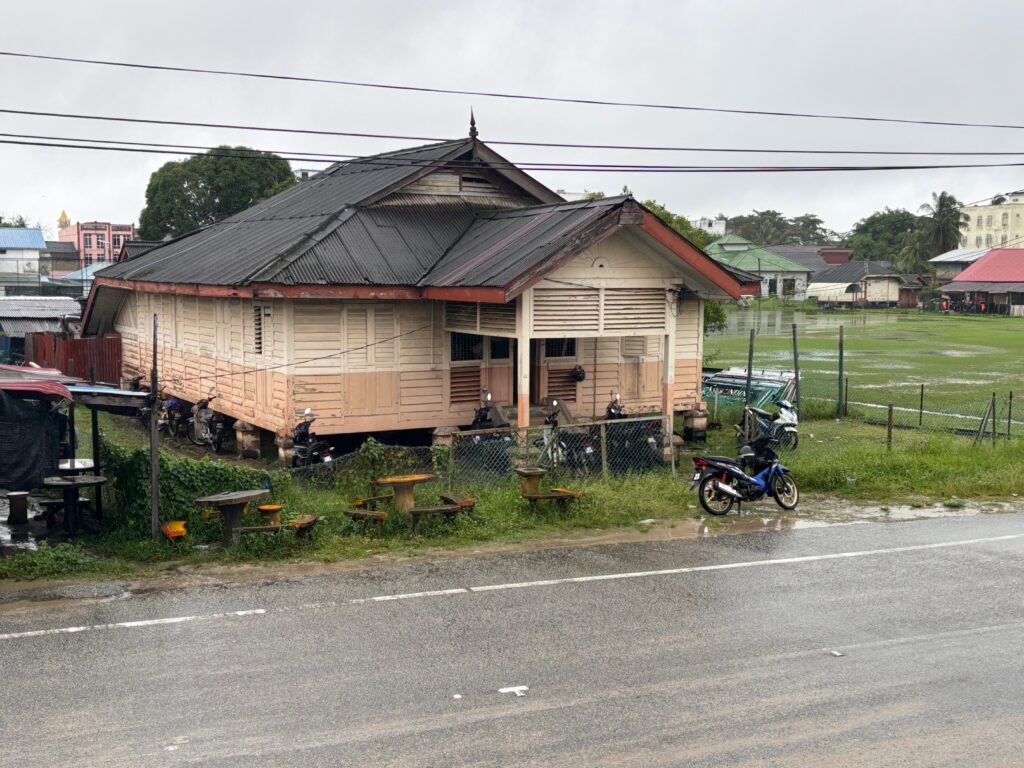
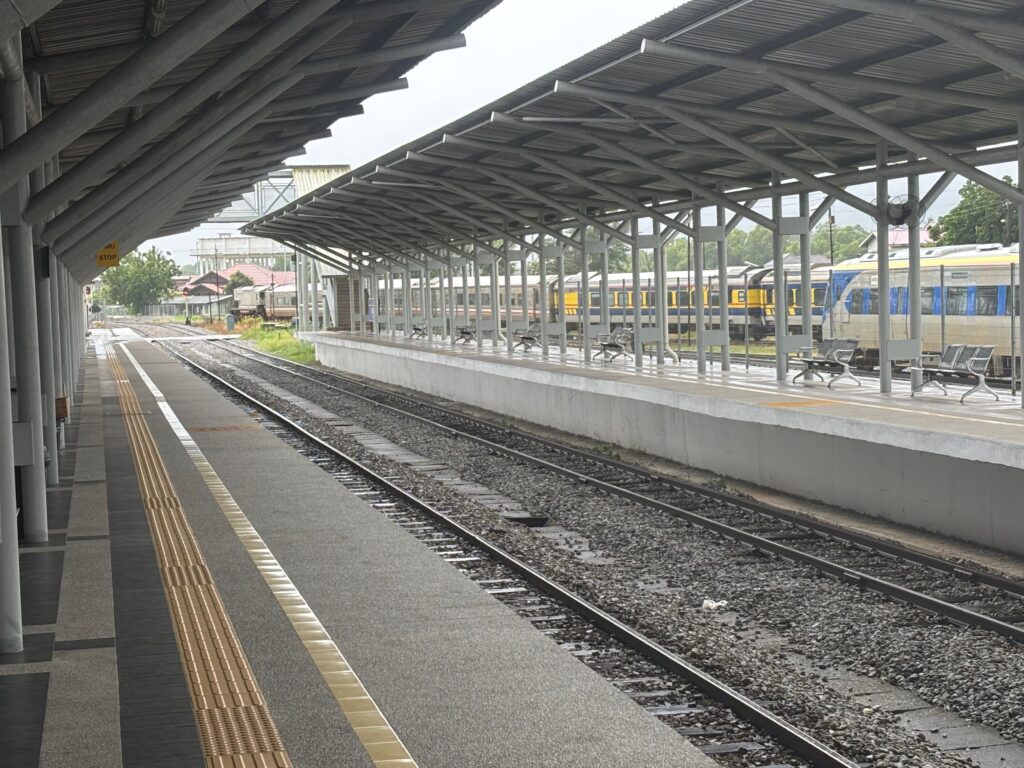
It was teeming down as my East Coast (Jungle) Railway train rolled into Tumpat, the northern terminus, marking exactly 527.75 km from the start at Gemas. Despite the rain, I wanted to do a little celebratory jump in the air to celebrate such a beautiful journey and a personal milestone of riding every train and monorail line through every station in Malaysia. I’ve also done this in New Zealand, Singapore, and Isle of Man!
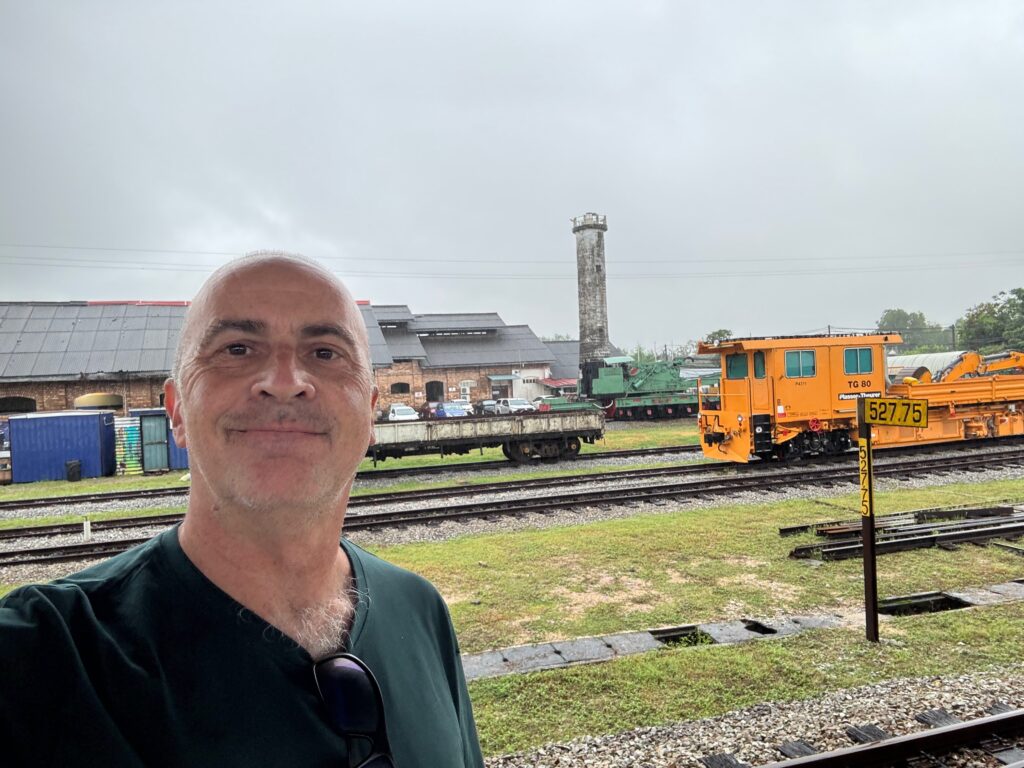

While Tumpat is the official end of the line, the tracks extend another 37 km to the Songkhla-Kalok Thai border. However, this section has been out of operation since the 1970s due to security concerns along the Thai-Malaysia border. The tracks remain intact, and there has been talk of reopening it, but the line may also be redundant if the new East Coast Rail Link, currently under construction in Malaysia, extends to the border.
I didn’t linger here for long. The pouring rain ruled out walking around the large 1930s train yard. Very few people got off at Tumpat (pop: 22,000), a small agricultural and fishing community. There are also some tourist resorts along the nearby South China Sea. Tumpat is home to several notable Buddhist temples, such as Wat Photivihan, which houses one of the largest reclining Buddha statues in Southeast Asia.
I watched my train as it pulled out to ready itself for the return journey overnight back to Johor Bahru. I felt a pang as it left. My Grab (car service) took me to my hotel in Johor Bahru where I had a day and a night before embarking on a walk across the border into Thailand and a train ride through the south of that country.
Conclusion
My journey on the Jungle Railway was a once-in-a-lifetime experience, taking me through the heart of Malaysia. The scenic views, historic stations, and rich natural environment left a lasting impression. Whether you’re a train enthusiast like me, or just seeking an unforgettable adventure, the Jungle Railway is an essential part of Malaysia’s railway heritage.
Future of the line
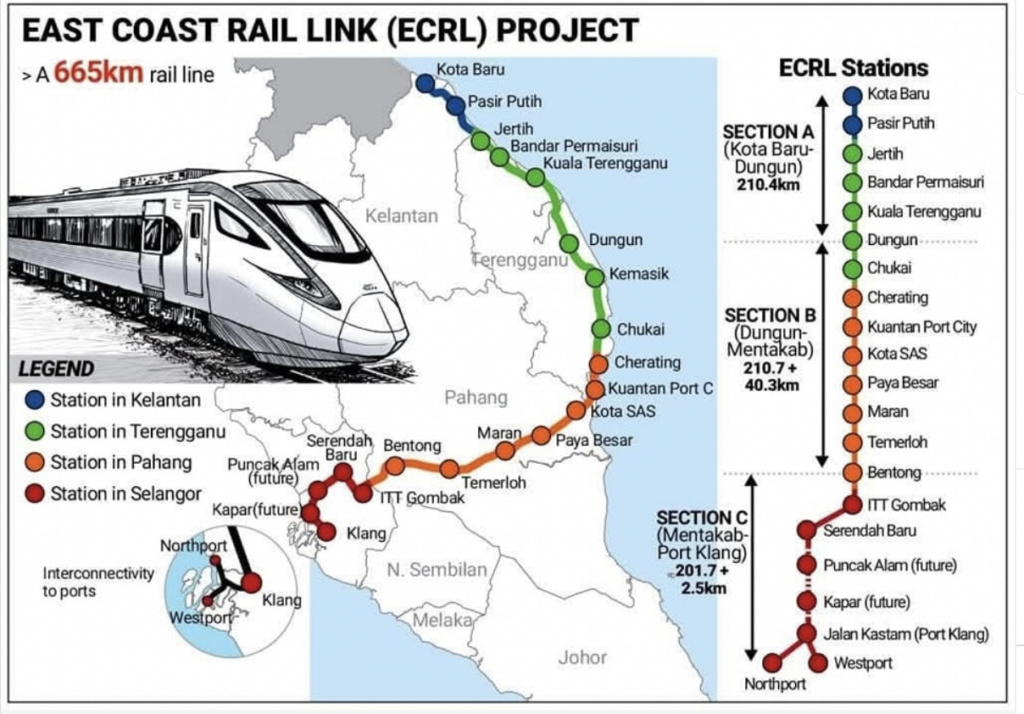
The world will change in 2027 when the electrified standard gauge double-track East Coast Rail Link (ECRL) connects Port Klang on the Straits of Malacca to Kota Bharu. Passenger services will be operated by a fleet of 11 sets of six-car CJ6-type electric trains, each accommodating up to 440 passengers. Shipping times will fall between China and Europe by two days.


we are planning to take this from JB and cannot decide whether to ‘re-position’ in Gemas so both legs of the route ar in daylight, or take the easy option and board in JB. would you say that the majority of the impressive scenery is after Kuala Lipis? thanks
Hi Martin,
Great account of the journery, very useful. Thank you.
I will be taking the trian from JB sentral all the way to the Wakad Bharu. Can you remember if there was a specific side of the train that had more intersting views? In particular, from Kala Lipis onwards. Thanks again!
Typo in your last para – car surely took you to your hotel in Kota (not Johor) Bahru?
To maximize the scenery should start in Tumpat and go to Gemas, or Gemas to Tumpat? I don’t have a ticket yet so please advise for this once in a life journey.
I’m in Hat Yai and need to decide where to start the jungle train. Maximize day time in the best parts of the journey.
Thanks for this great travel experience. May I know which hotel did you stay at Kuala Lipis?
Thanks! This is very inspiring! I am definitely going to do it this year after reading your account of the journey!
Very interesting